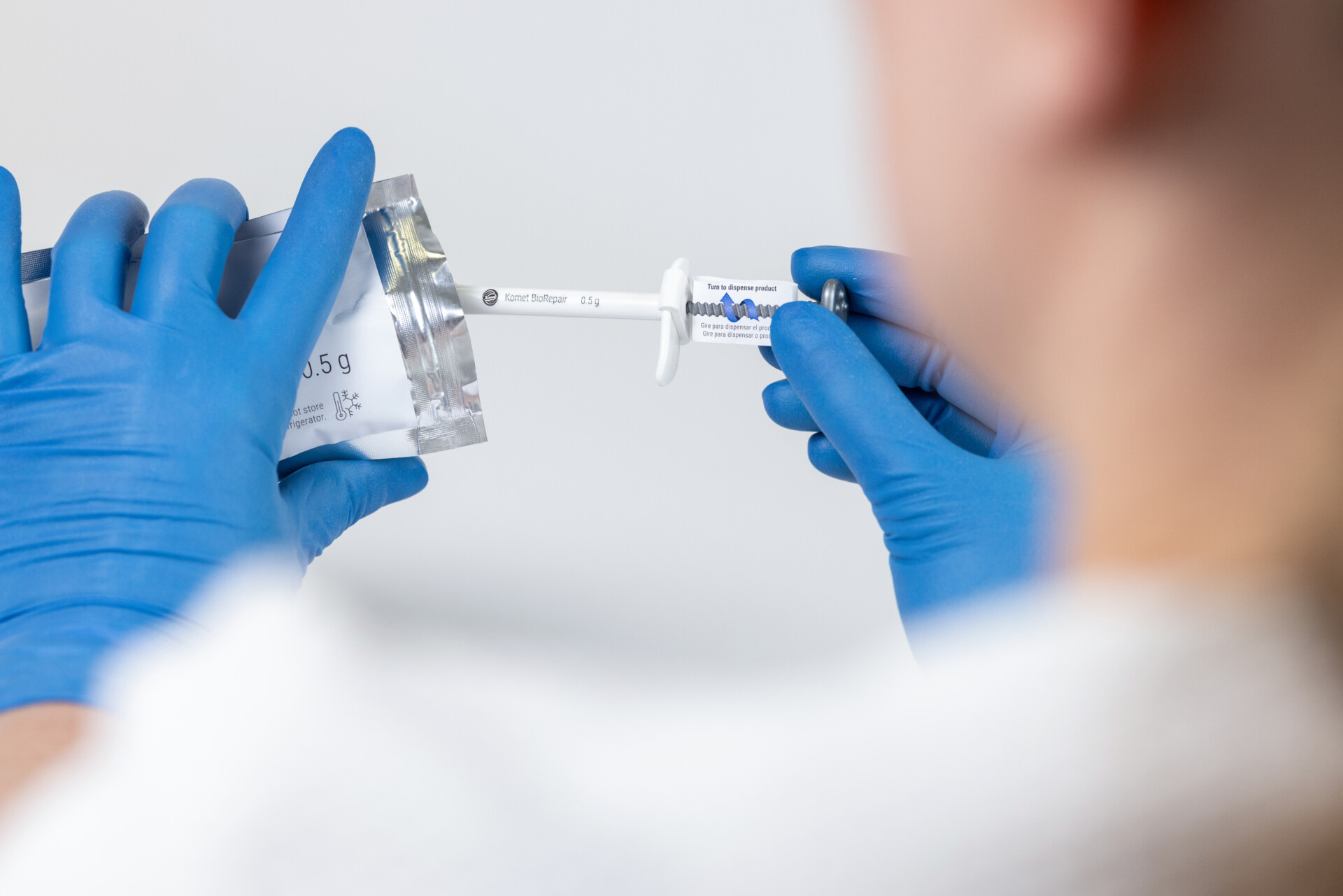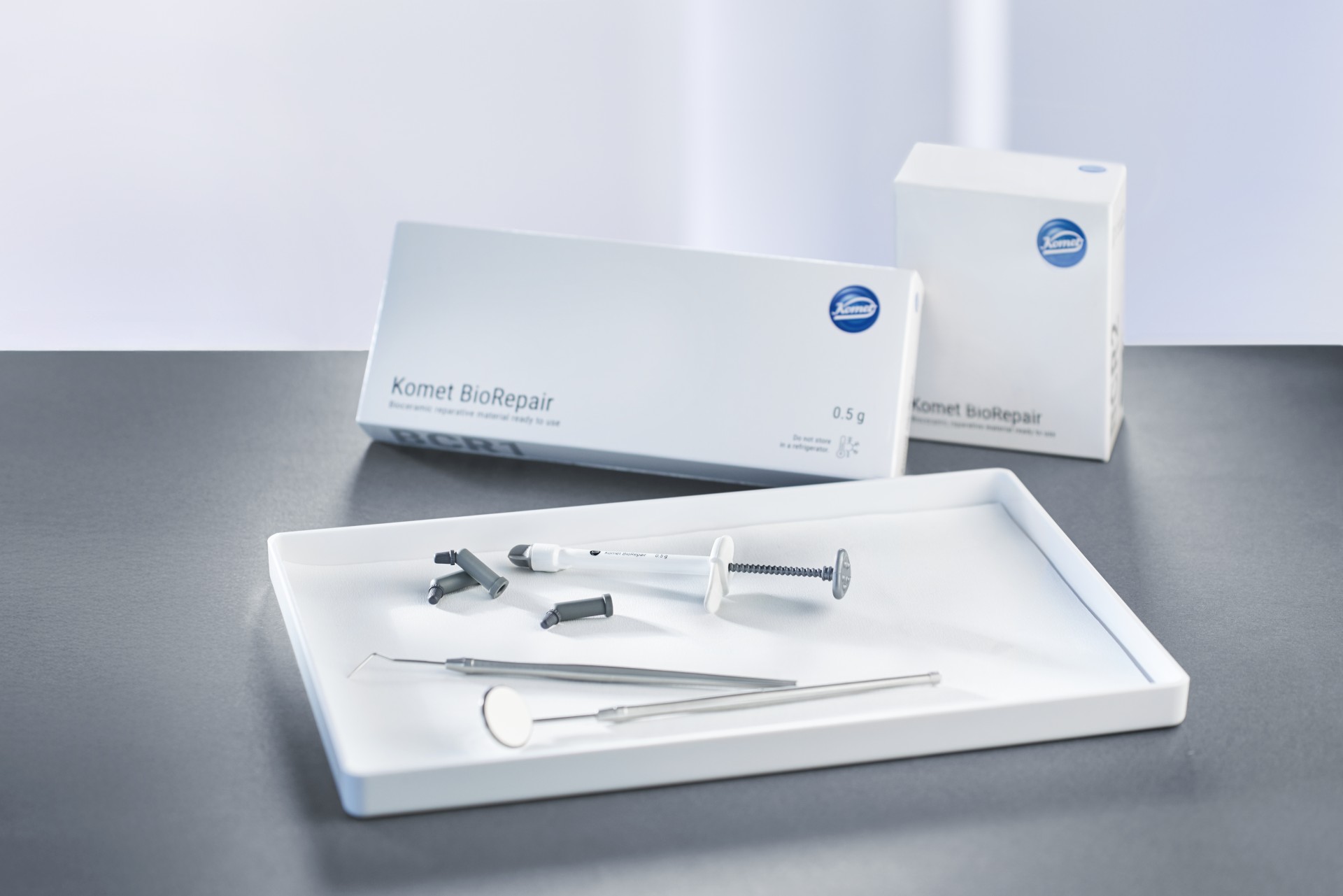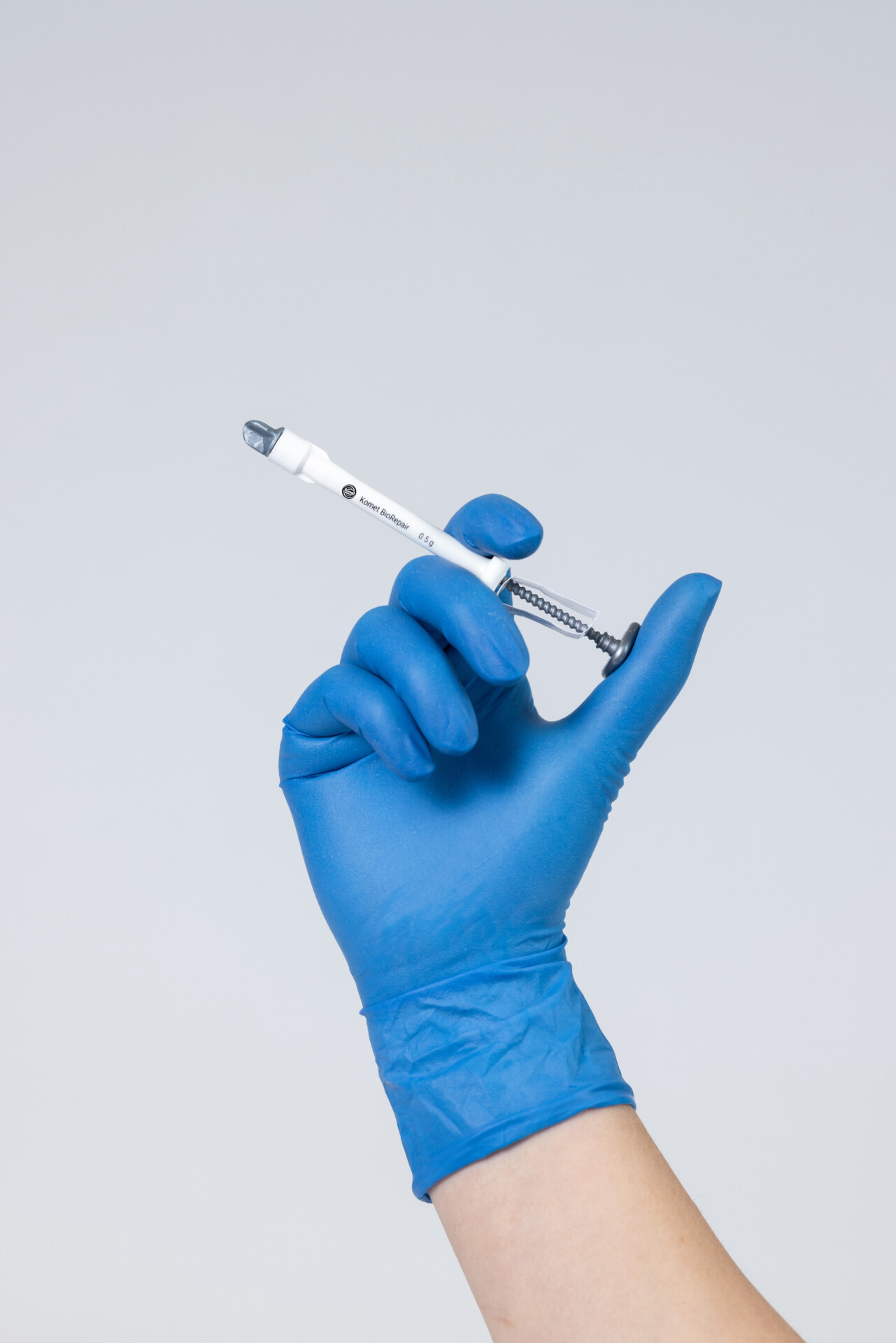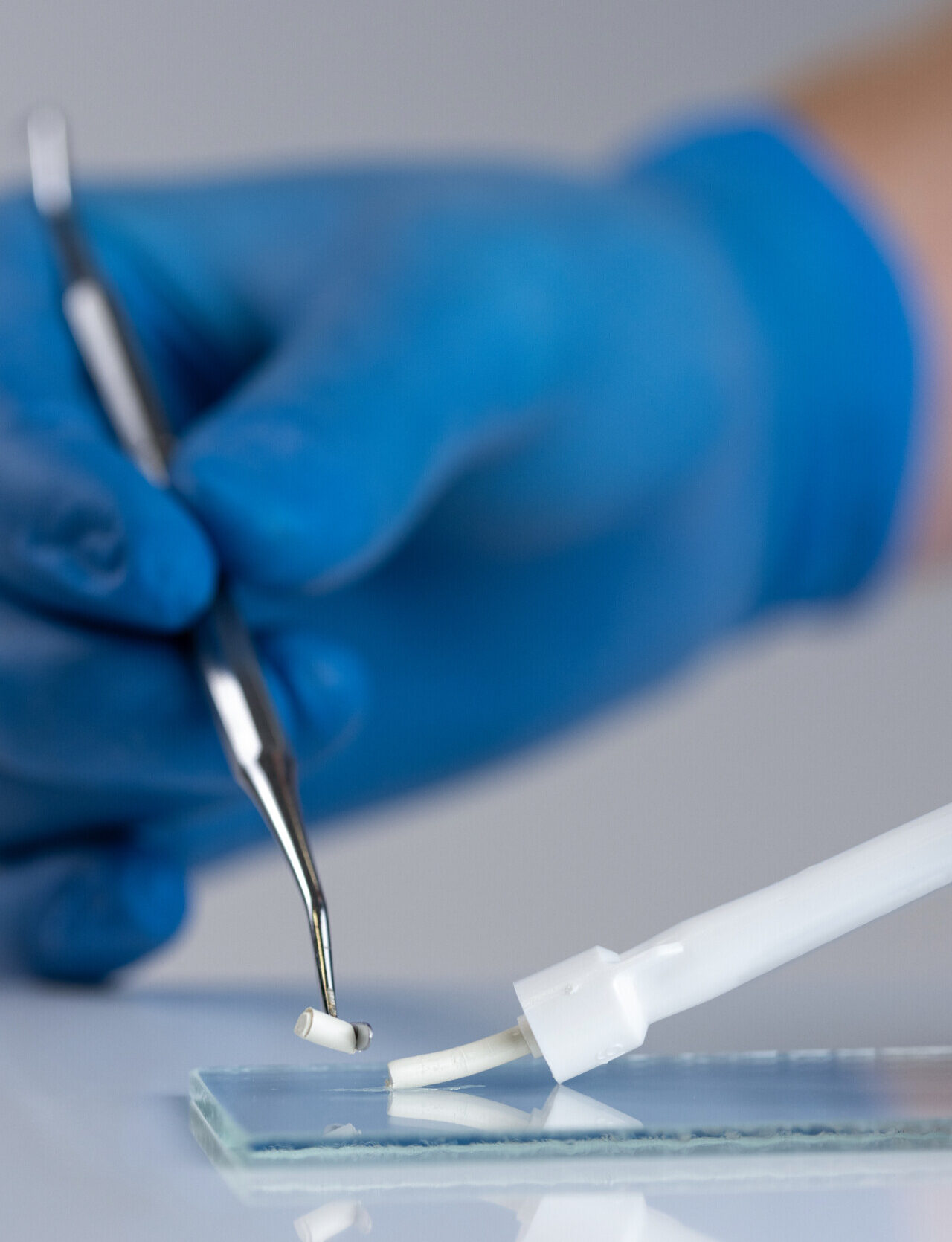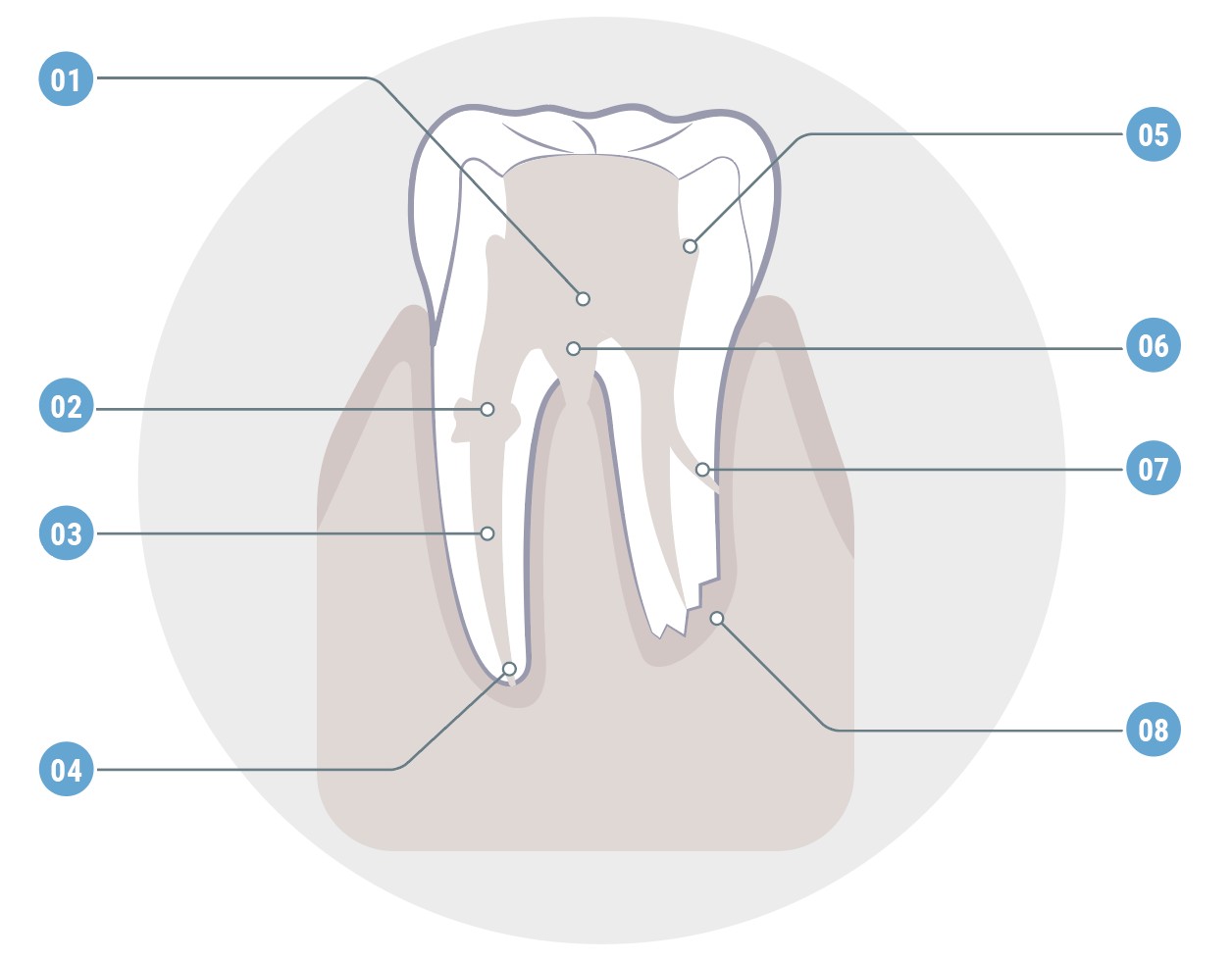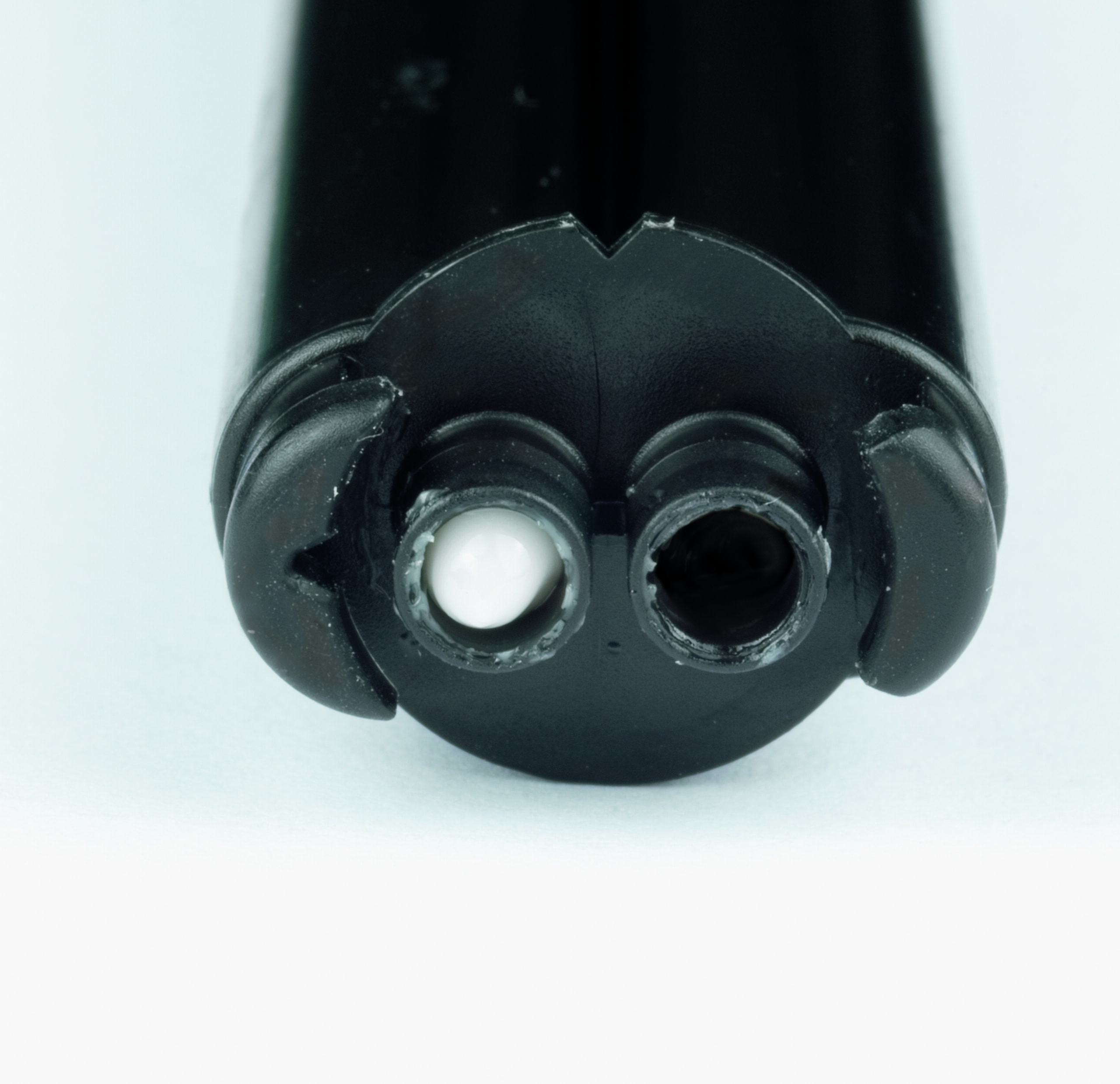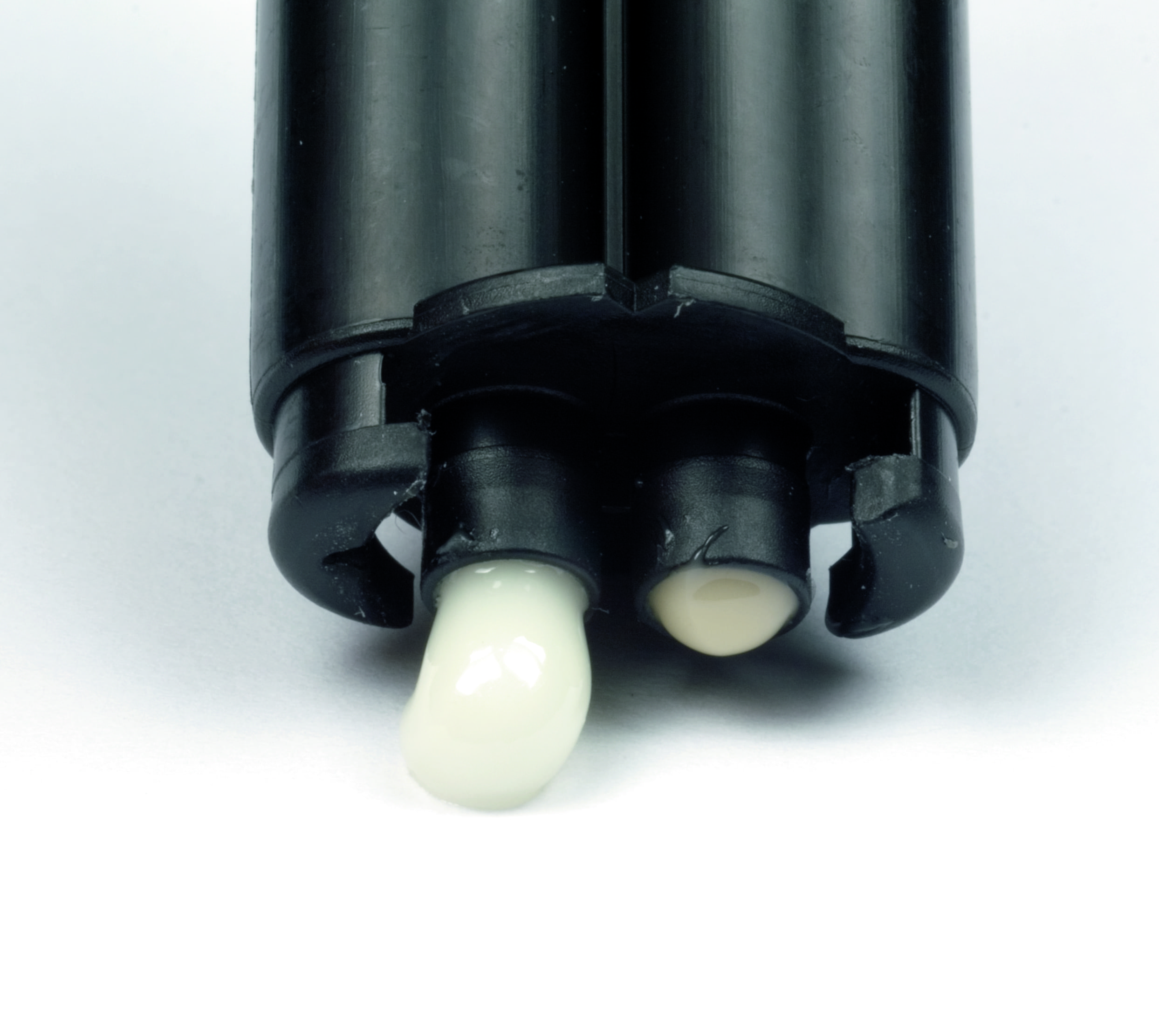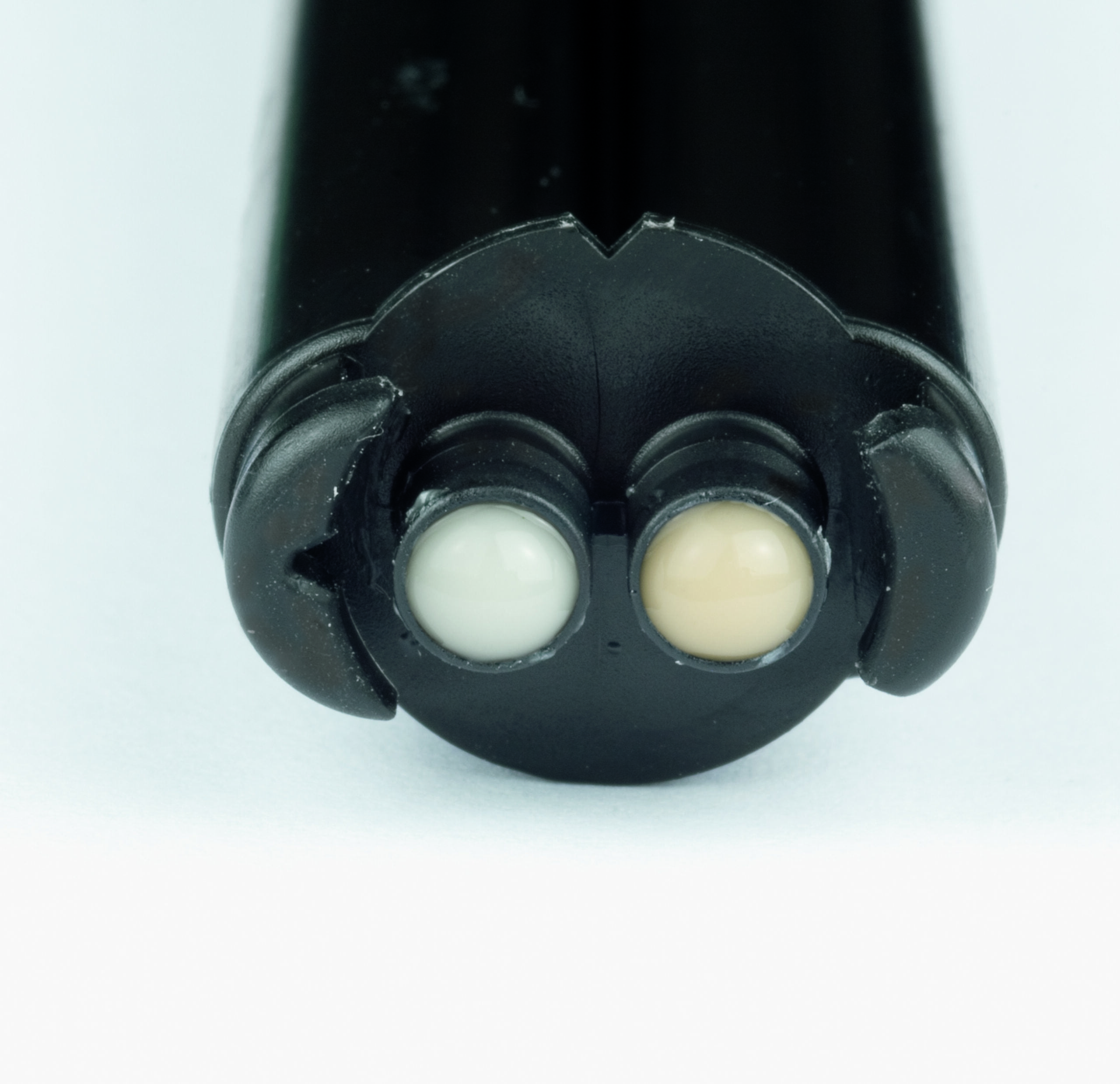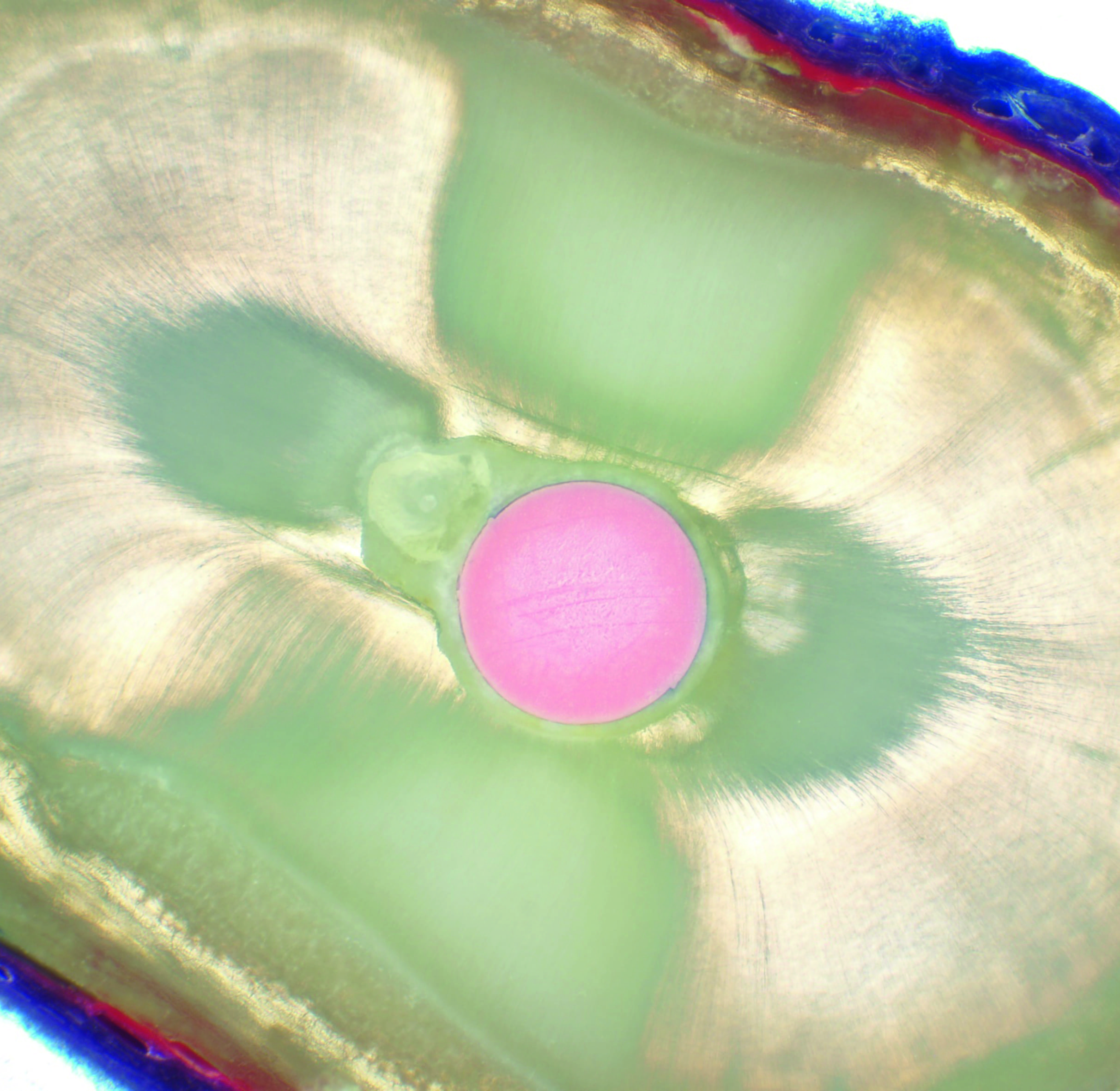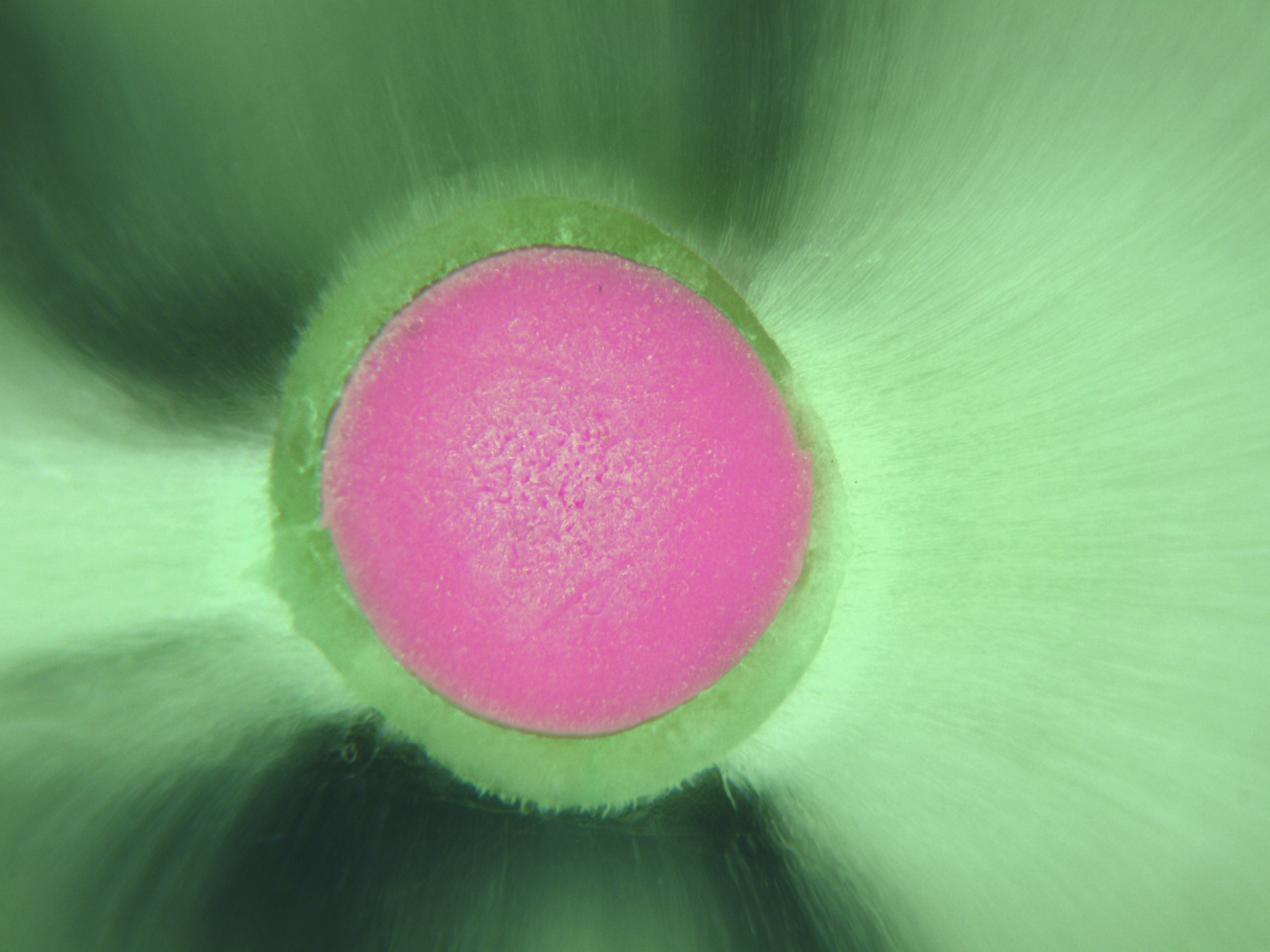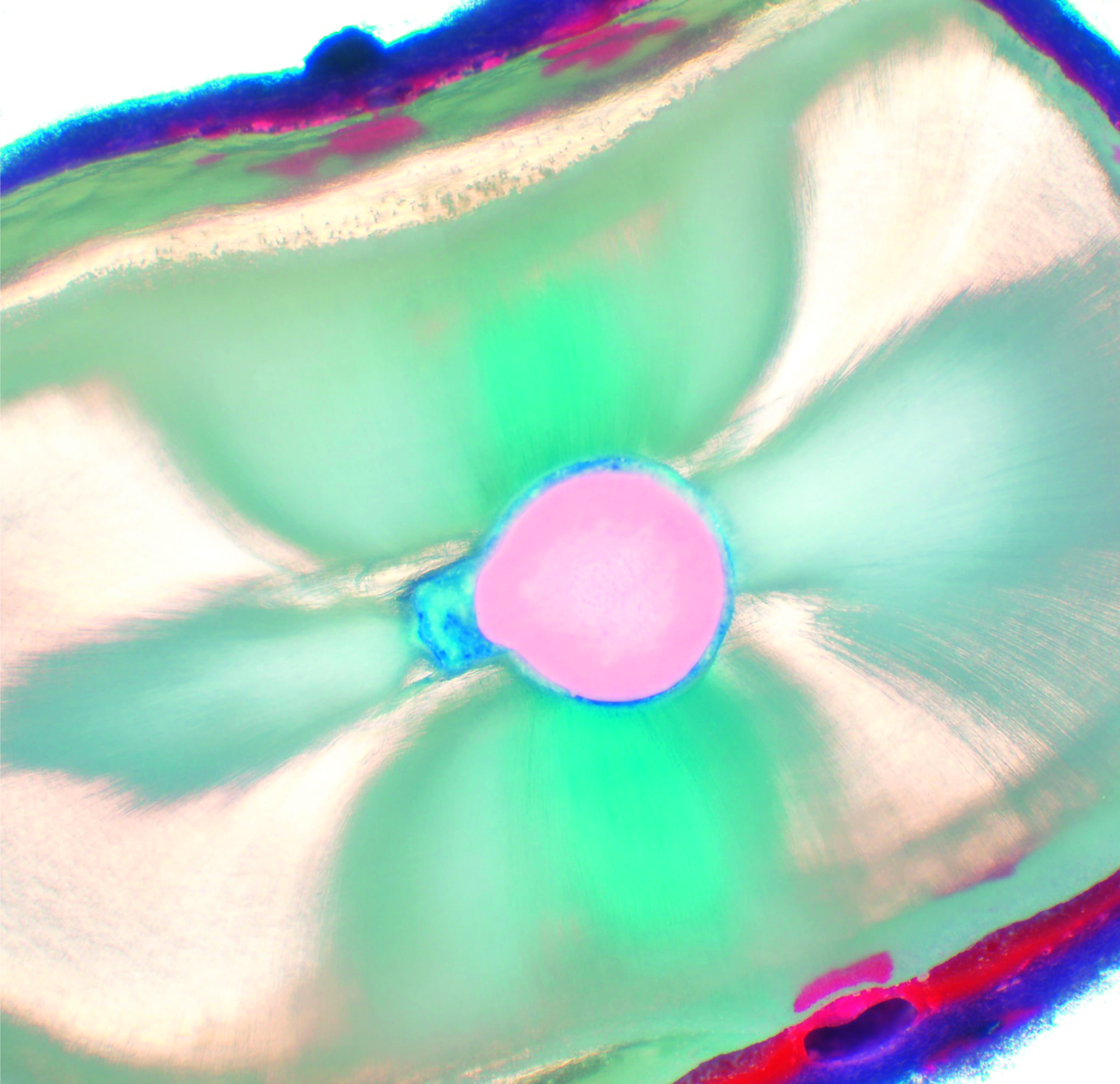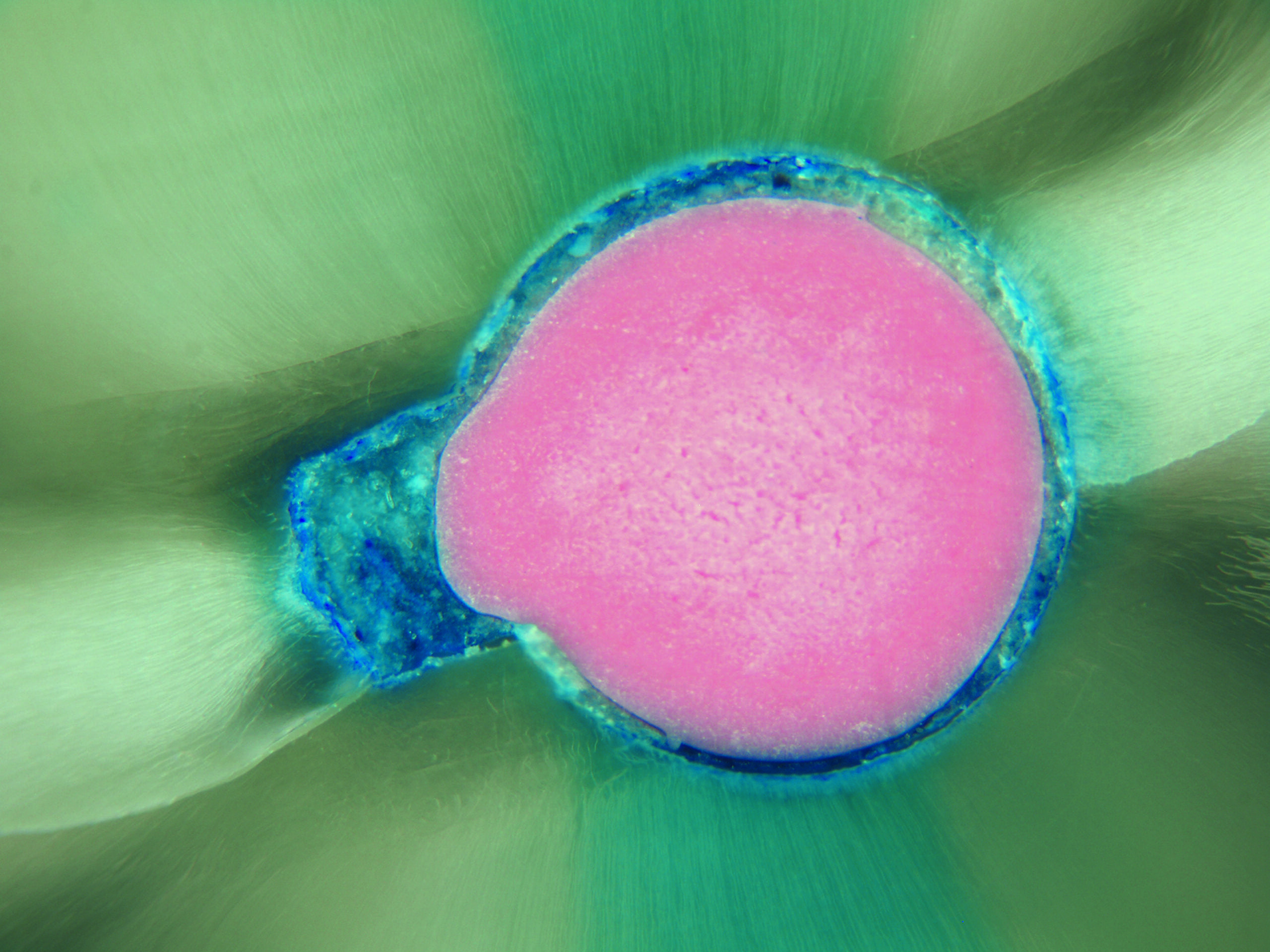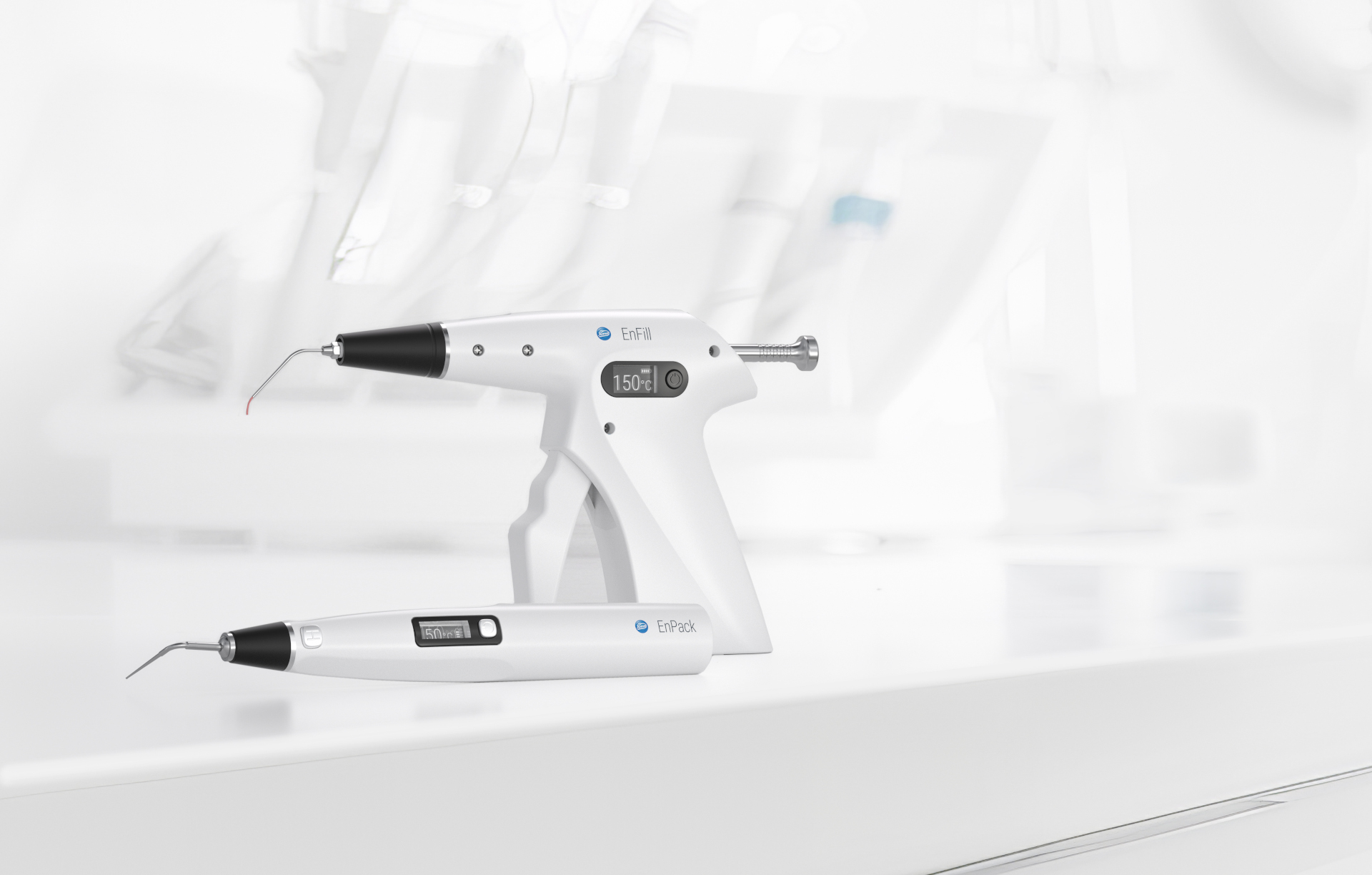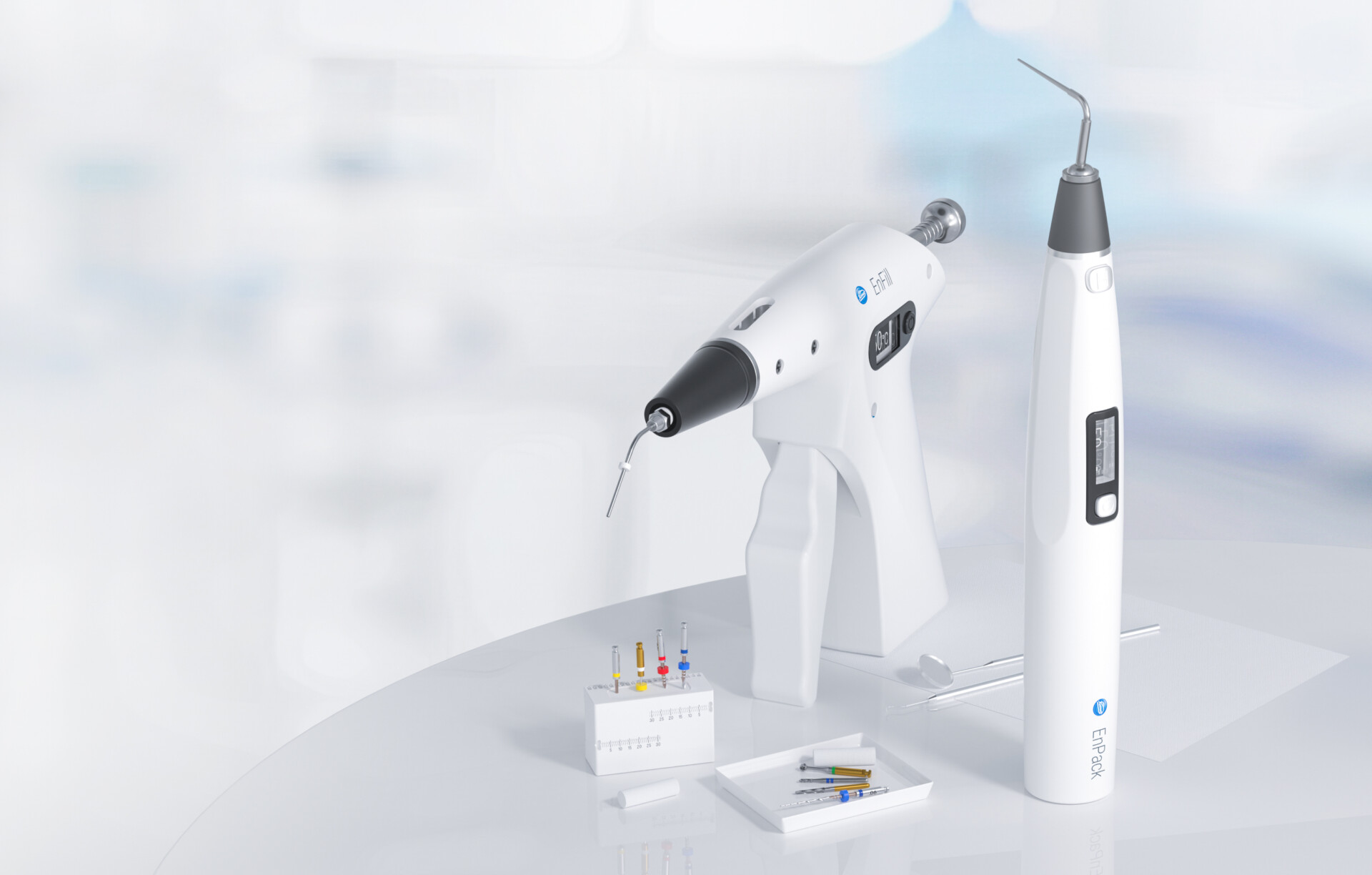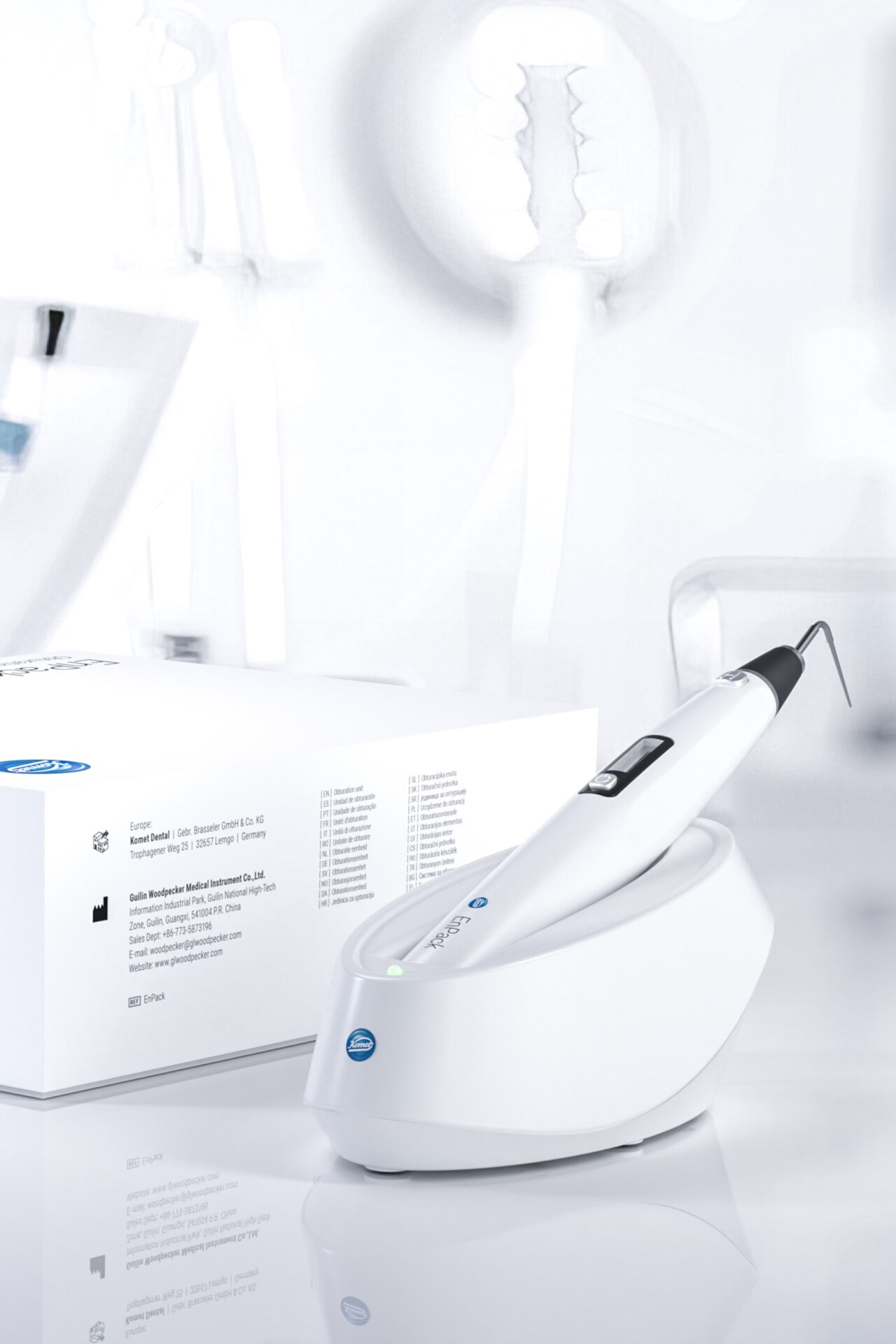Obturation
After the preparation and chemical cleaning of the root canal system, the canals have to be tightly sealed with a suitable obturation to prevent reinfection. Komet provides a comprehensive range of paper and gutta-percha points as well as F360 Fill, a carrier-based filling system. Komet BioSeal is a bioceramic sealer and EasySeal is a sealer based on epoxy resin. Root canal sealers are mainly used to fill voids, seal additional root canals and multiple foramina. What’s more, endodontic sealers are intended for creating a bond between the filling material and the canal wall and for encasing residual bacteria in the canal.
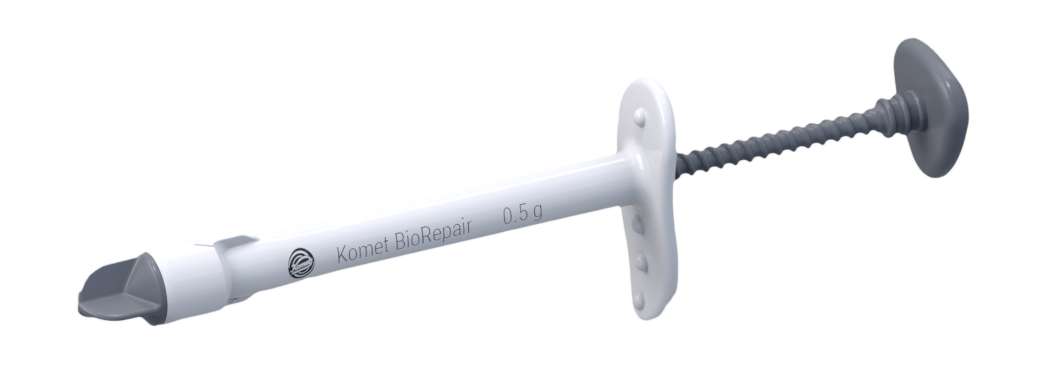
Komet BioRepair
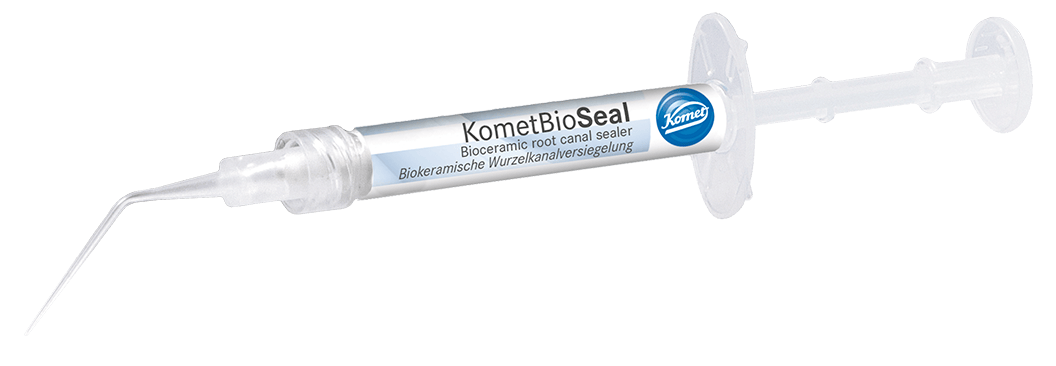
Komet BioSeal
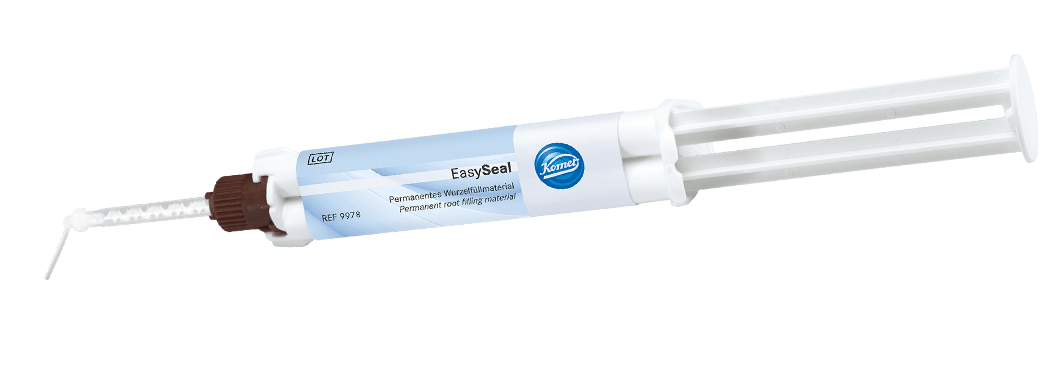
EasySeal
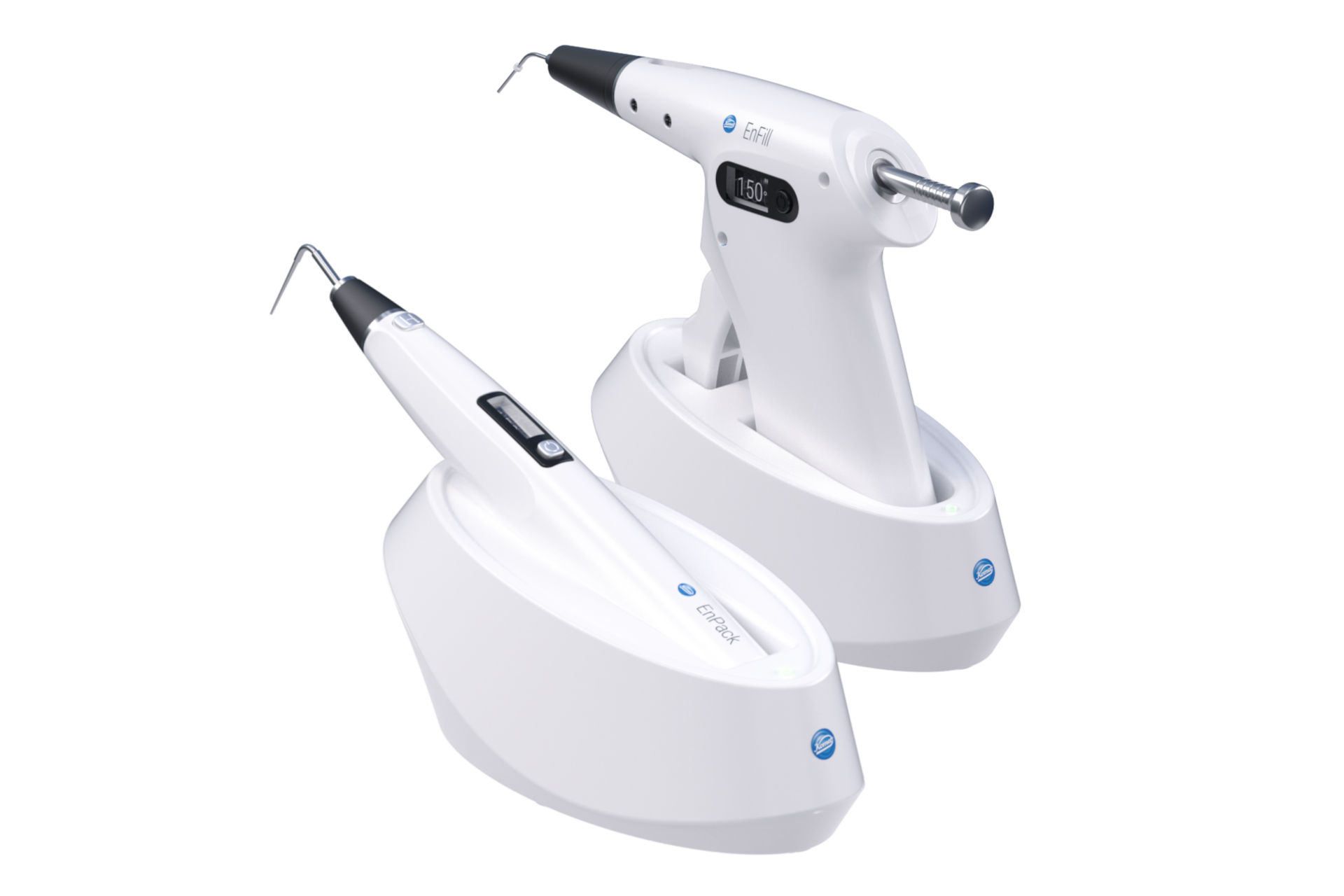
EnFill & EnPack
Komet BioRepair
Take dental excellence to the next level and discover the ready-to-use solution for vitality preservation.
The priority of a dentist is to preserve the natural teeth of his patients. With the new BioRepair Putty, Komet enables dentists to do just that. But that’s not all: thanks to its vitality-preserving properties and stimulation of the healing process, the bioceramic material offers new and effective treatment options not only for average patients, but also challenging patients – in short: solutions that previously seemed impossible. In addition, the ready-to-use consistency of the putty simplifies the process without compromising the established Komet quality.
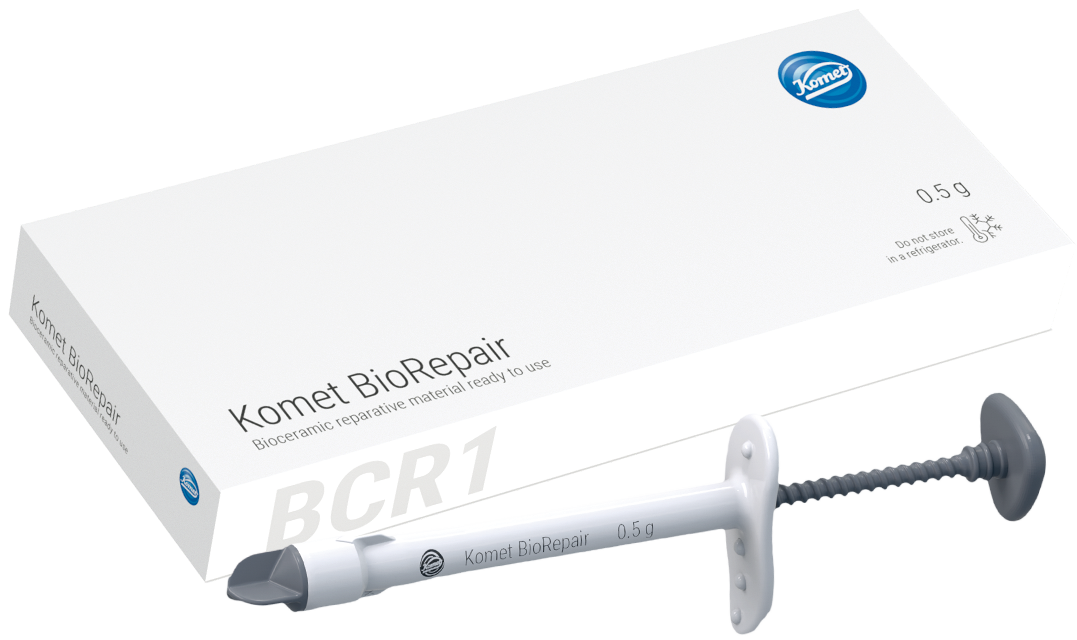
When treating patients, the preservation of their natural teeth is a top priority for every dentist. However, there are many factors that make treatment more difficult: Some have a weakened bone structure, while others require solutions that do not impair their root growth.
With BioRepair Putty, Komet now offers a solution for eight different indications that is specially tailored to these challenging cases. Thanks to its bioceramic formula, the material induces periradicular cementum neoformation and stimulates the repair process in damaged periradicular tissues – allowing dentists to perform treatments that were previously unthinkable.
What’s more, BioRepair Putty is supplied as a ready-to-use solution, saving both time and money. As the material does not need to be mixed at the dental practice, you can immediately benefit from the consistently high Komet quality with every application.
The allrounder for your endodontic treatments.
Treating all patients for 8 different indications with just one easy-to-use solution – Komet BioRepair truly lifts endodontic treatments to the next level. Discover the remarkable properties of Komet BioRepair and find out how you and all your patients will greatly benefit from it.
Benefits
8 different indications a single all-in-one solution.
Komet BioRepair is ideally suited for the effective treatment of 8 different indications – and each treatment can be carried out with the same solution.
User friendly application.
Komet BioRepair Putty is supplied as a premixed solution, which not only ensures easy application, but also enables faster treatments.
Preserves vitality & stimulates regeneration.
The superb vitality-preserving and tissue stimulating properties of Komet BioRepair make it a particularly suitable solution for the treatment of challenging patients.
No discoloration despite extensive tooth repair.
Another advantage of Komet BioRepair lies in its aesthetic properties, as the color of the treated teeth is not affected even in case of extensive repairs.
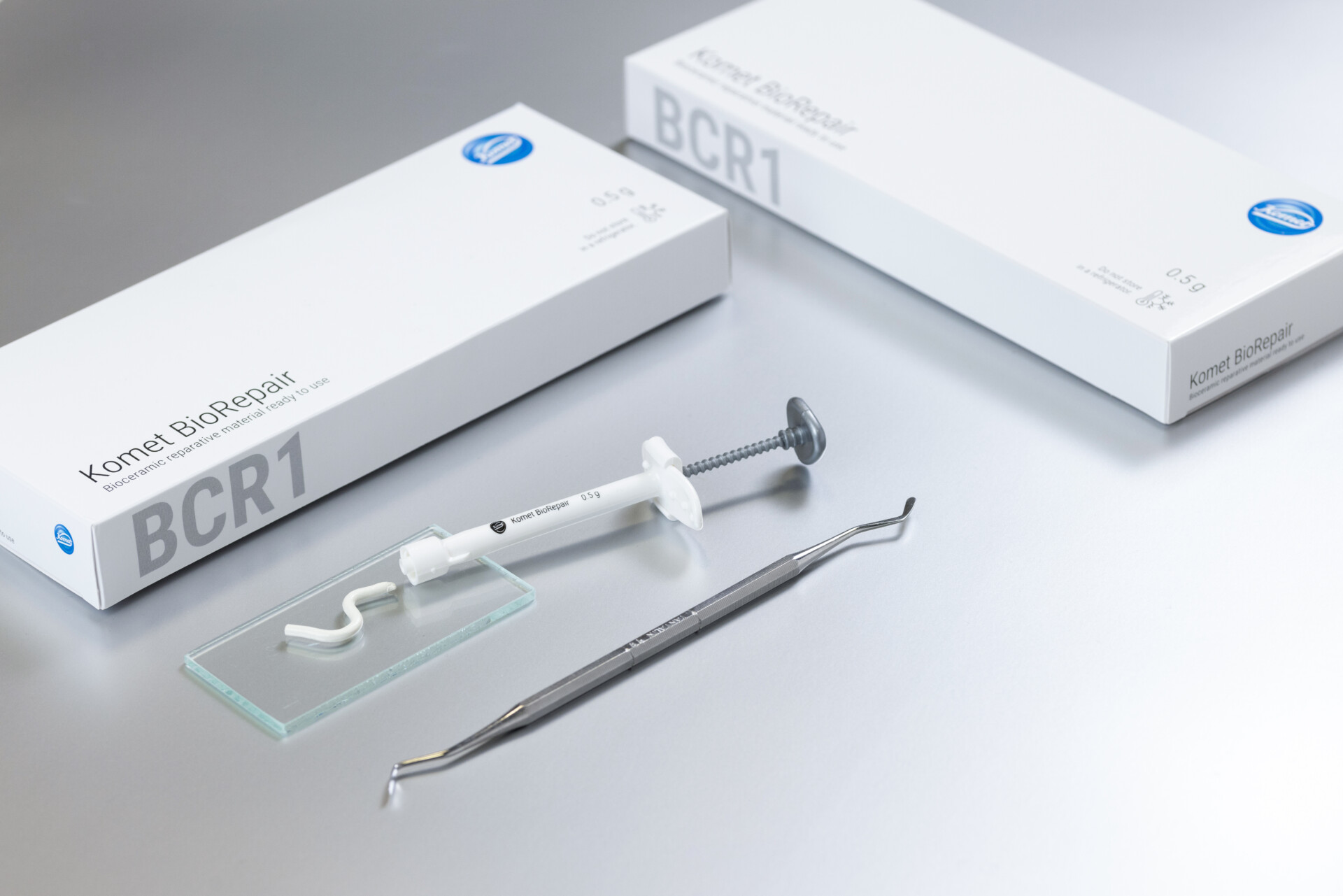
Most important characteristics
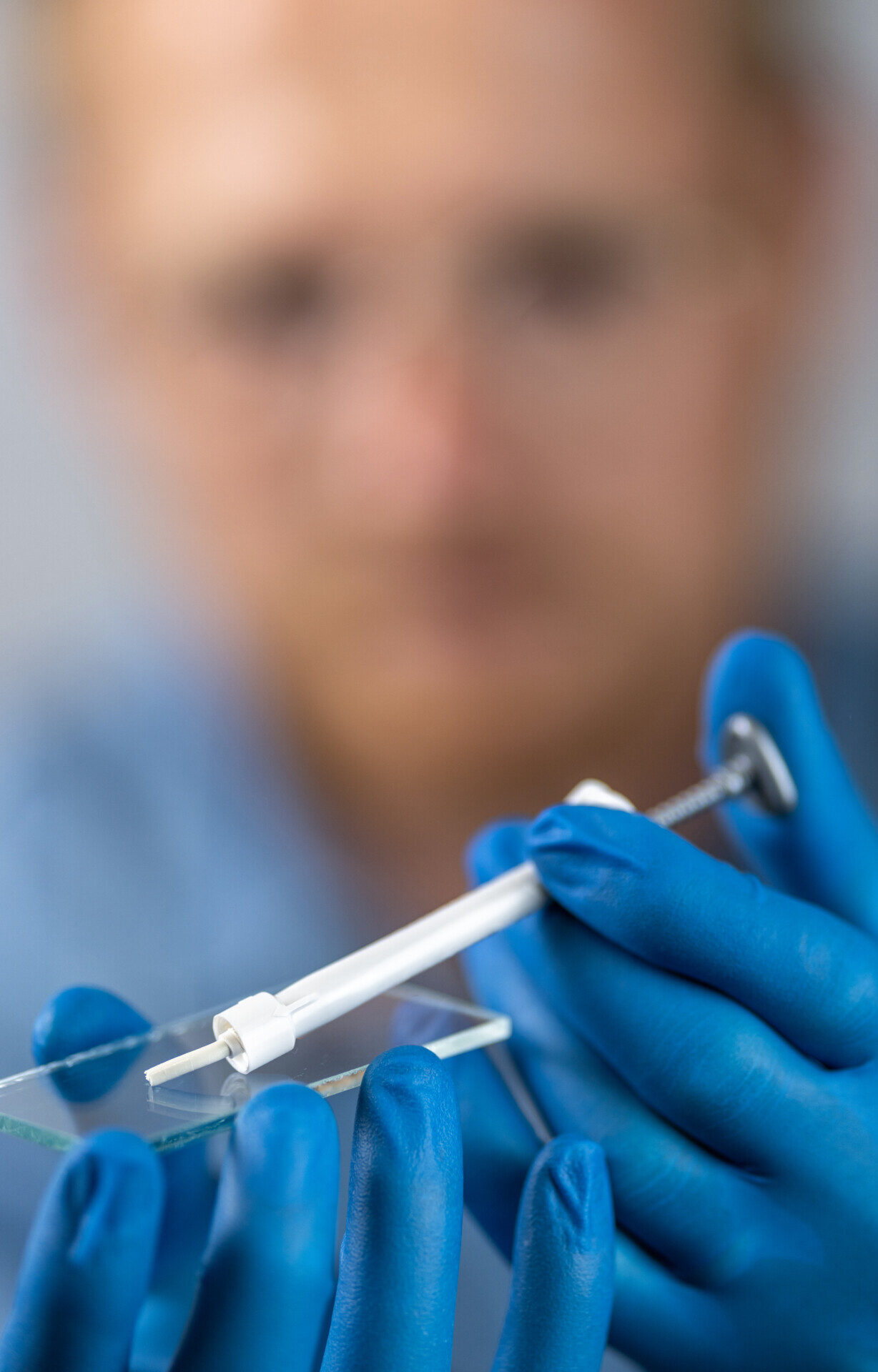
Ready-to-use solution
BioRepair is already mixed when it reaches your dental practice.This saves you costs and eliminates the need for staff training.
Consistent quality
The pre-mixed putty rules out user errors, enabling you to benefit from the consistently high Komet quality every time you use it.
High radiopacity
Thanks to its high radiopacity, Komet’s BioRepair is easy to detect on X-ray images. This makes it easier to check the correct application.
Excellent aesthetics
The ingredients of BioRepair do not cause any discoloration, thus ensuring an aesthetically pleasing result and satisfied patients.
Long-term effect
The long-term prognosis of endodontic treatment improves.Thanks to its vitality preserving properties, our putty not only opens the door to new treatment options for average patients, but is also particularly suited for treating challenging patients.
Bioceramic formulation
BioRepair Putty is composed of calcium silicates and does not contain any heavy metals.
Hydrophilic material
The material of our putty needs moisture to start the setting process. This reduces stress for the dentist, as the cavity no longer needs to be completely dried before application.
Inhibits bactericidal growth
The bactericidal action thanks to a strong alkaline pH value of ~12 helps to prevent infections at an early stage – a feature which is further enhanced by using a material that does not shrink during the setting process, leaving no space for bacterial infiltration.
All-in-one solution
BioRepair can be used for eight different indications. It can therefore replace other materials and facilitate your storage management.
Step by Step: Root Resorption
Learn how to use it in your daily treatments.
1. Anesthetize and install the absolute isolation
2. Remove the granulation tissue of the reabsorption area
3. Neutralization of the medium with calcium hydroxide paste
4. Remove the calcium hydroxide paste in the following session and execute endodontical treatment in the conventional way until the height of the reabsorption
5. Apply Komet BioRepair to the area of reabsorption, condensing it against the walls with specific instruments or a sterile ball of cotton slightly moistened
6. Execute the coronal sealing with glass ionomer and restoration with the material preferred
7. X-ray and archive radiographs according to the legal provisions valid in the respective country.
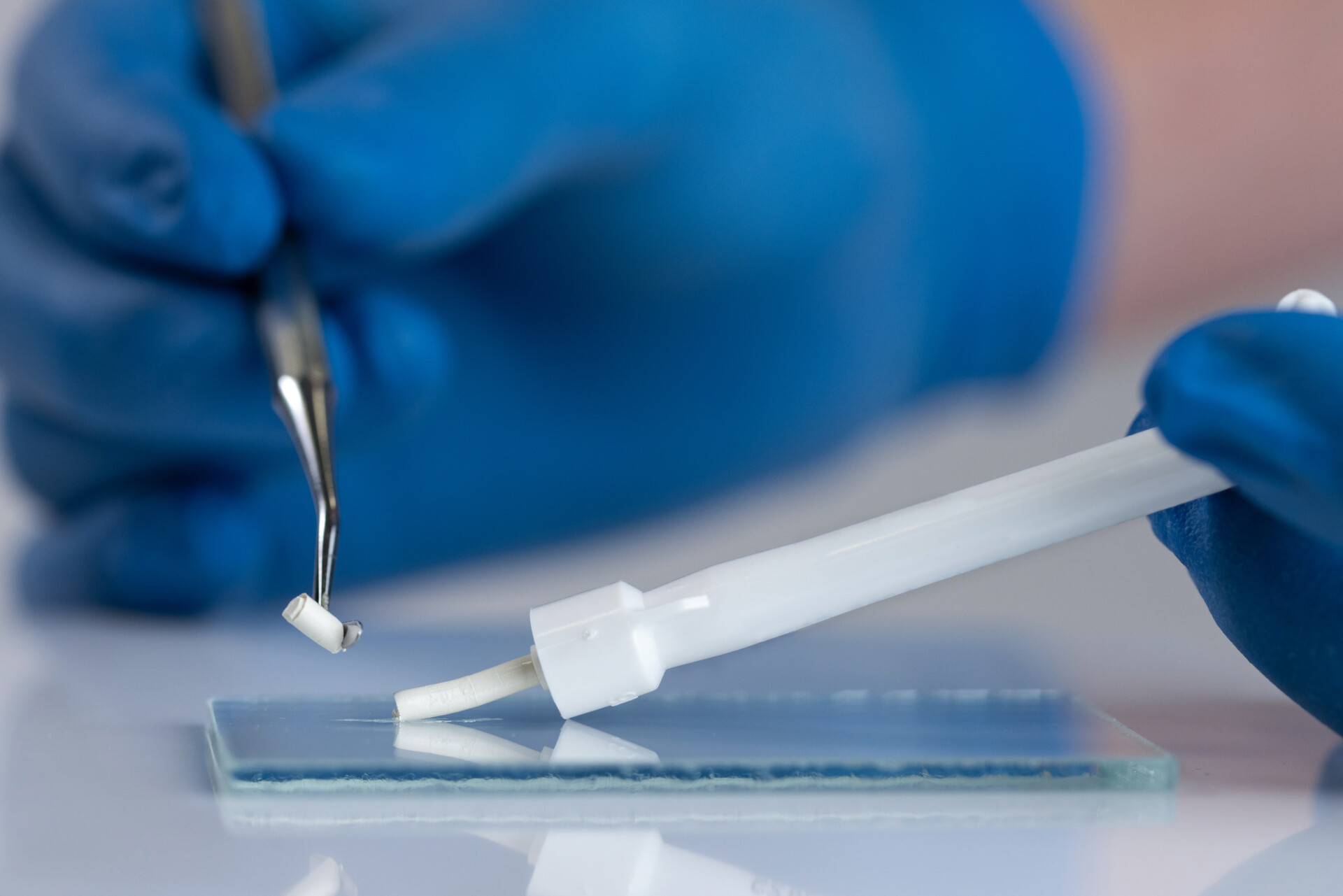
Case study: Partial pulpotomy with Komet BioRepair
With BioRepair, Komet offers general dentists and endodontists an efficient and easy-to-use solution that effectively supports them in treating these particularly sensitive cases where the preservation of tooth vitality and regeneration properties play a key role. Read the full story & learn more now!
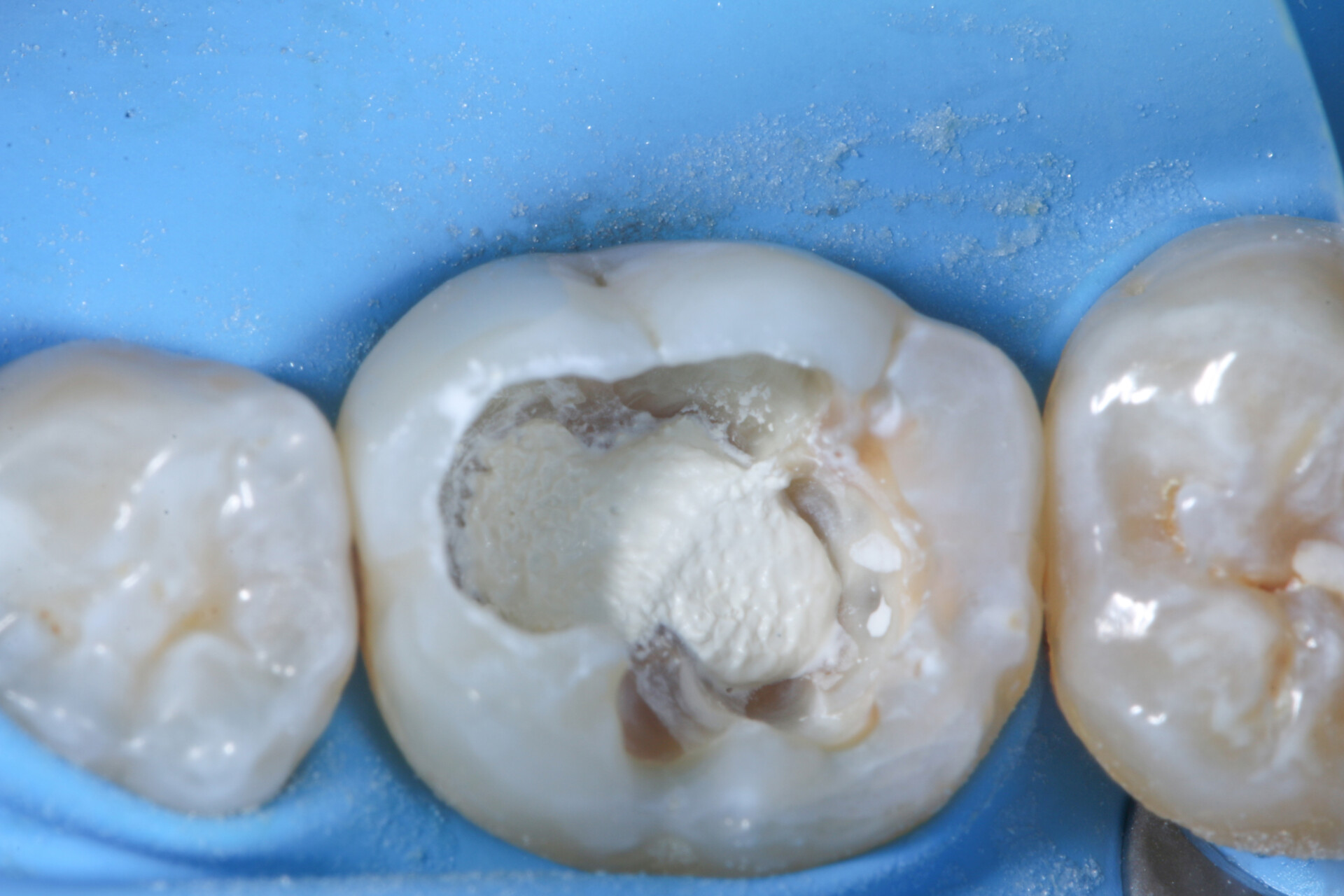
1 solution for 8 indications:
Komet BioRepair’s superb versatility.
With Komet BioRepair putty material, 8 different endodontic indications can be tackled with ease! Our innovative all-in-one solution streamlines your practice, offering consistent, high-quality results for every patient.
Simplify your toolkit, maximize your efficiency!
Complementary products
perfectly coordinated.
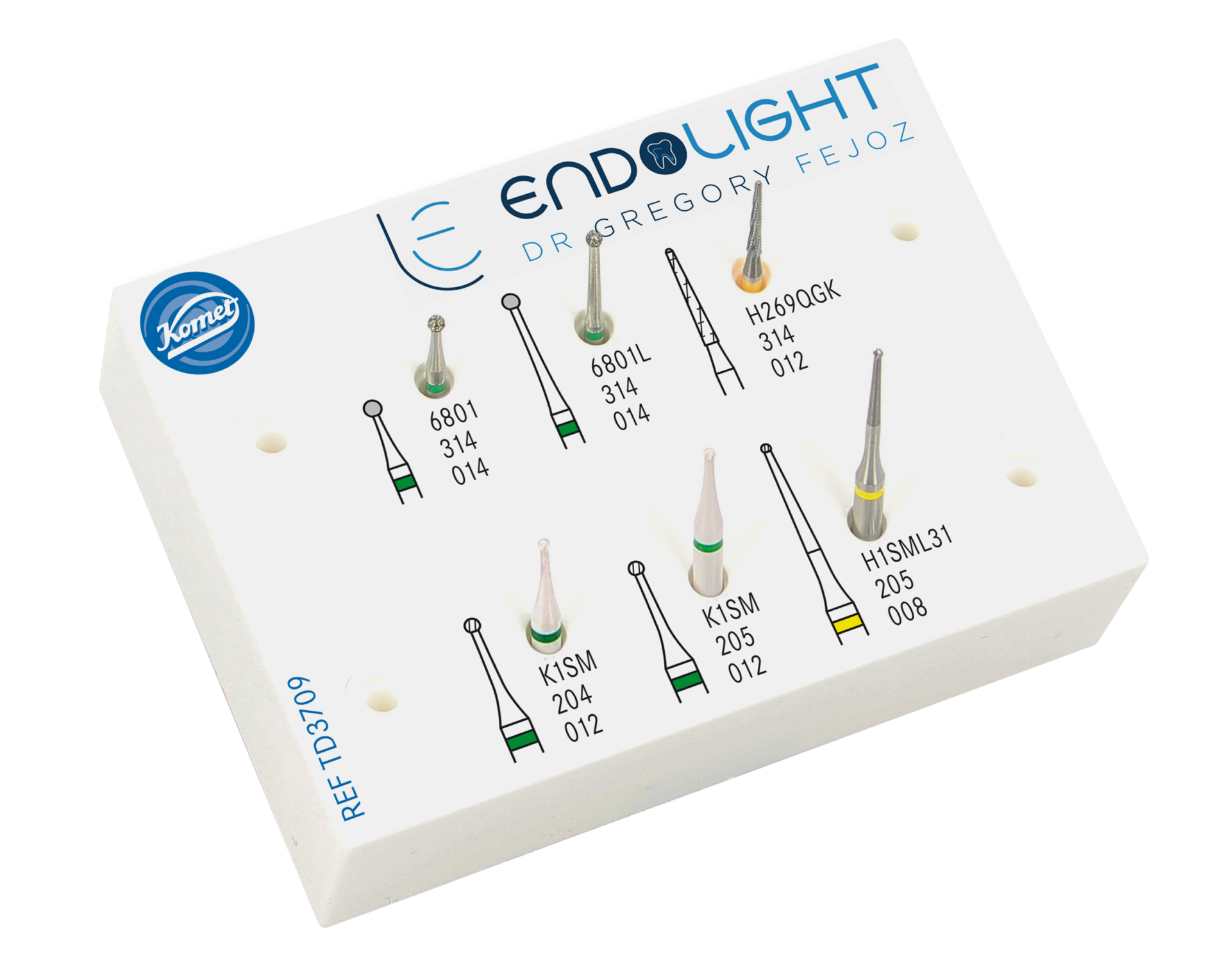
TD3709 – Kit Pulpotomy Dr. Grégory Fejoz
- Specific pulpotomy set for vital pulp treatments
- Developed with Dr. Grégory Fejoz – France
- Indication step – Pulpotomy and Pulp Protection

PolyBur – P1.204.014/018/023
- Excavation in the vicinity of the pulp
- Ideally suited for minimally invasive excavation near the pulp thanks to its self-limiting properties
- Indication step – Pulp Protection

SonicTips – SF55/16-17/20-21/56-57.000
- Sonic tips for the retrograde preparation of the root canal during apicectomies
- Minimally invasive approach without preparation of large bone windows
- Indication step – Retro-Filling (apicectomies)
Komet BioSeal
Komet BioSeal is a new endodontic bioceramic obturation material which perfectly meets all the demands placed on a modern root canal filling material.
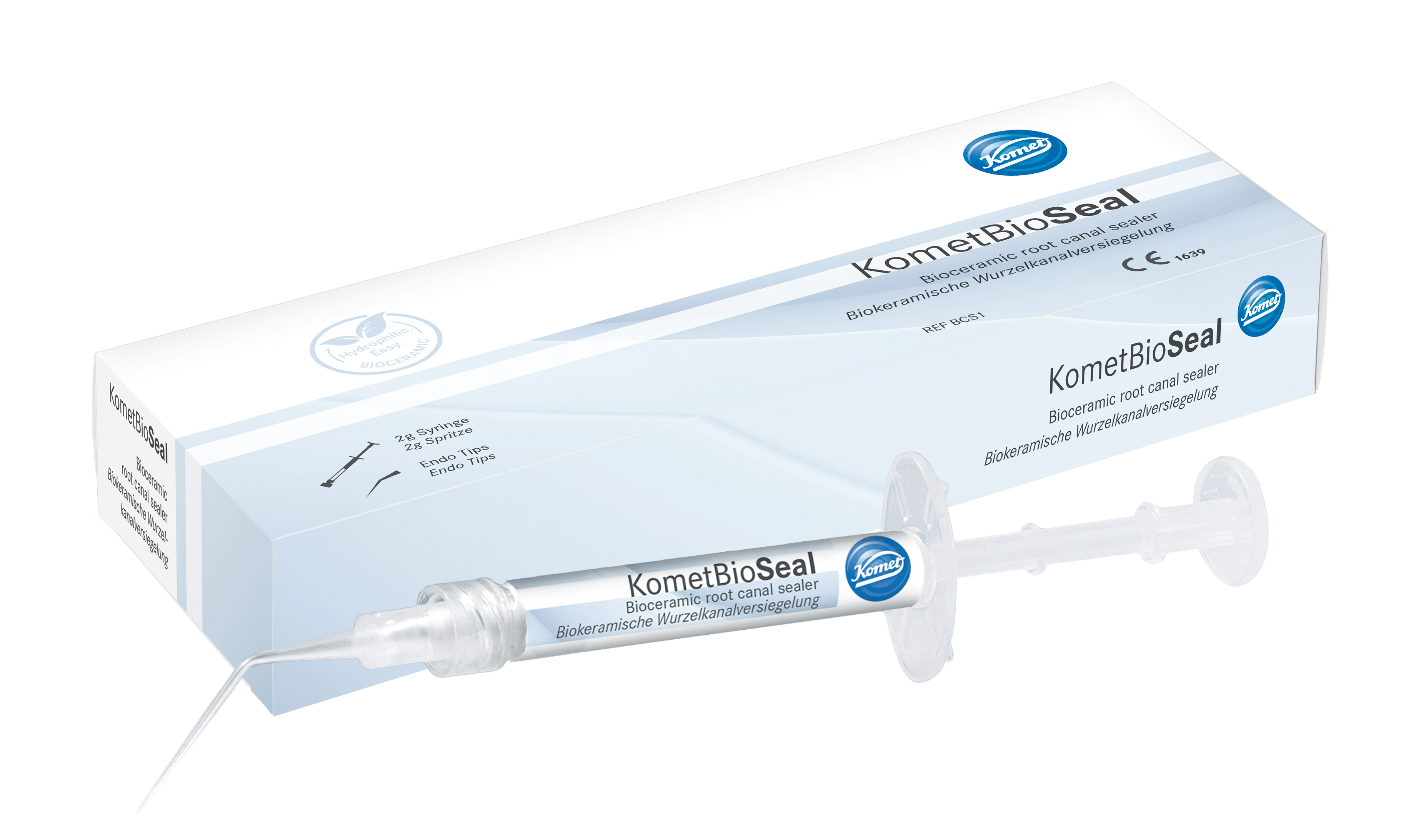
Advantages
Bactericidal effect:
Komet BioSeal has the ability to effectively eliminate existing bacteria in the root canal. Komet BioSeal owes its excellent antibacterial effect to the initially high pH value during curing.
Excellent biocompatibility:
Thanks to its calcium-silicate based material, Komet BioSeal has an excellent biocompatibility after having set and, therefore, prevents foreign body reactions by the surrounding tissue. This, in turn, promotes quick healing and reduces post-operative pain.
Easy application and short curing time:
Komet BioSeal has hydrophilic properties and is ready for use. Unlike conventional sealers based on epoxy resin, Komet BioSeal uses the residual moisture from the dentinal tubules for curing. Thanks to the short curing time, combined with the easy and safe application, predictable and reliable obturation results can be achieved using cold filling techniques (for example single-cone technique).
Optimum sealing ability and perfect adhesive bond:
Highly flowable, Komet BioSeal has an optimum sealing ability and creates a perfect adhesive bond between the dentin and gutta-percha. In combination, these two properties prevent the reinfection of the root canal after obturation.
Highly radiopaque:
The specific composition of bioceramic sealers is a real challenge in terms of radiopacity. Thanks to its optimized material composition with zirconium oxide particles, Komet BioSeal is distinguished by an excellent radiopacity.
Step by Step.
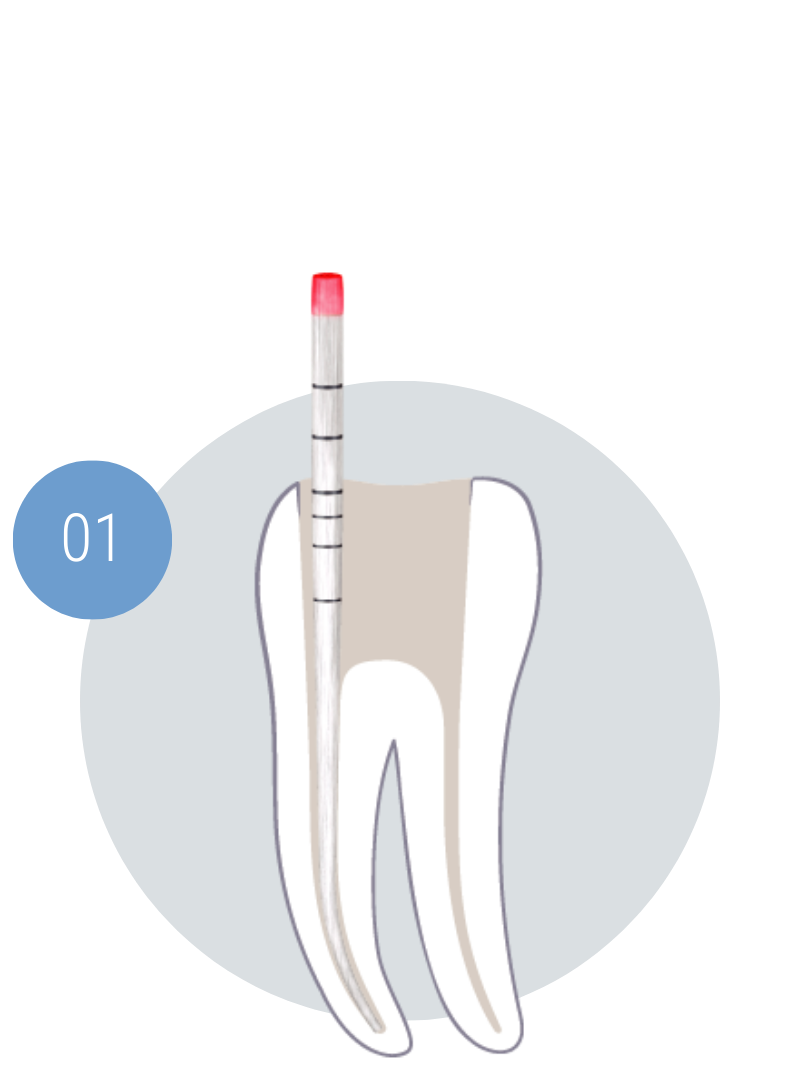
After the final rinse, the canal system is dried with paper points of congruent shape and the gutta-percha is adapted.
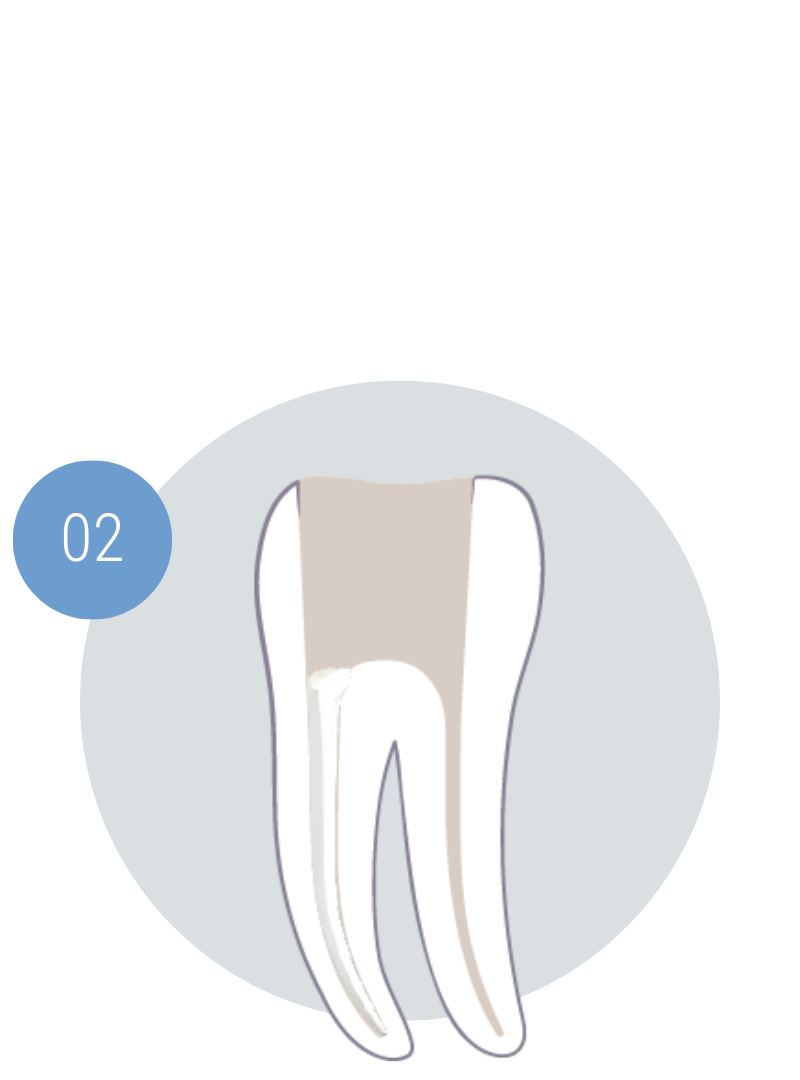
The root canal system is filled with KometBioSeal through the fine tip of an application syringe.
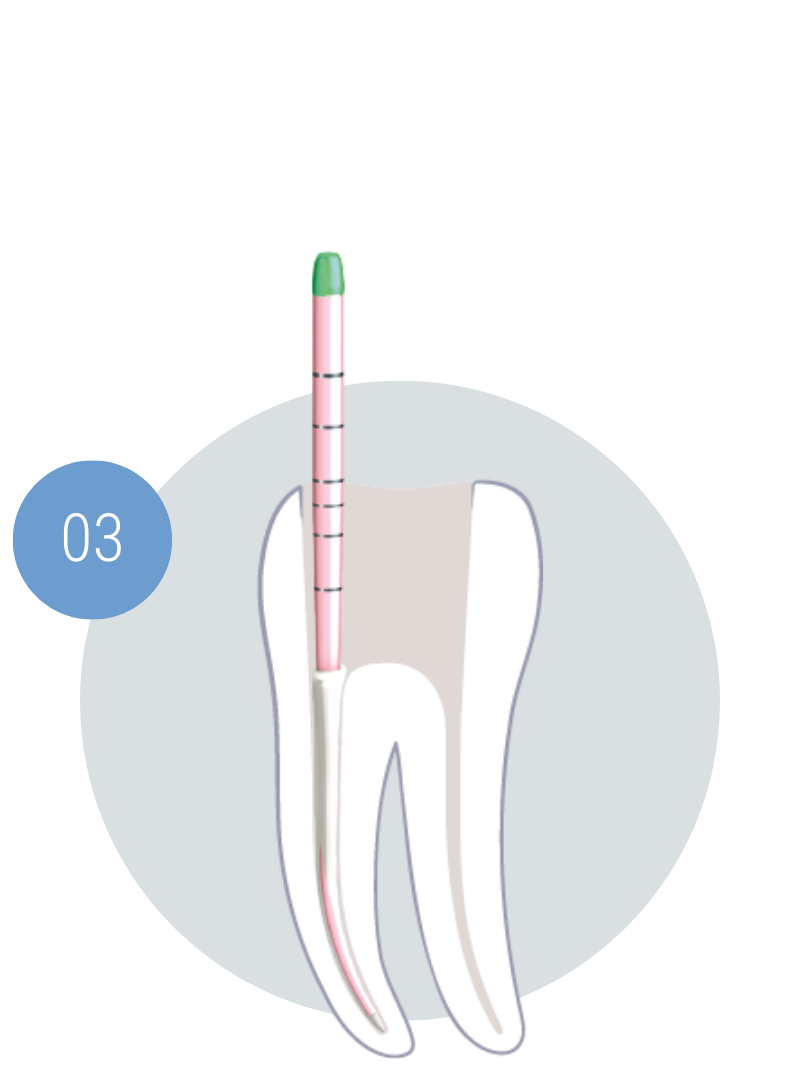
The guttapercha point is inserted with pumping movements and shortened to the correct working length, for example with the EndoPilot Downpack handpiece
See how to use Komet BioSeal
Why bioceramic?
Root canal sealers mainly serve to seal voids, additional root canals and multiple foramina. What’s more, endodontic sealers are intended for creating a bond between the filling material and the canal wall and for sealing off residual bacteria in the canal.
Bioceramic materials have been used in numerous other medical disciplines for many years, for example in orthopaedics. Thanks to KometBioSeal, these materials can now also be used in endodontics.
Advantages
Bactericidal effect:
KometBioSeal owes its excellent antibacterial effect [ 2 ] to its initially high pH value during the curing phase. This means that any bacteria that may be present in the root canal are eliminated. Thanks to its consistently high pH value that remains stable for several days, the disinfecting effect of KometBioSeal is similar to that of a calcium hydroxide insert.
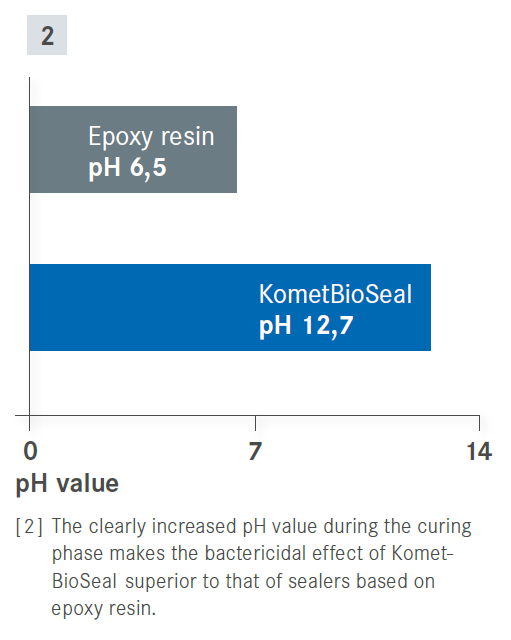

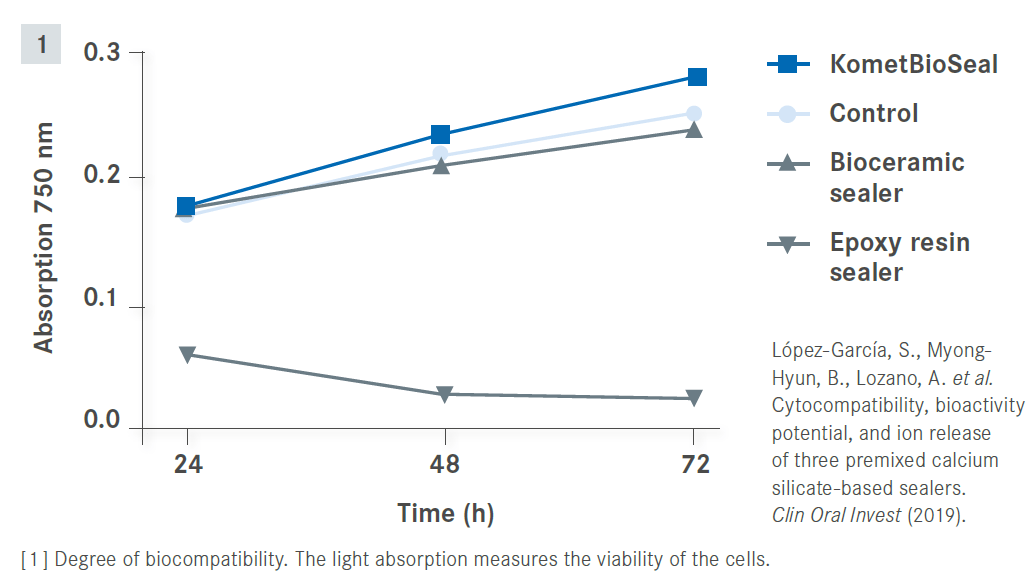
Excellent biocompatibility:
KometBioSeal is based on calcium-silicate, which is why it is particularly biocompatible after the curing phase. In addition, it emits calcium ions [1]. These properties prevent foreign body reactions and, in turn, accelerate the healing process. In addition, cells that have settled on the sealer exhibit a positive proliferation.

Perfect adhesion and easy application:
The adhesion values of KometBioSeal are similar to those of epoxy resin sealers, which facilitates a perfect adhesive bond between the dentin, KometBioSeal and the gutta-percha. Moreover, KometBioSeal has hydrophilic properties, which means that, contrary to conventional sealers based on epoxy resin, KometBioSeal uses the residual moisture in the dentinal tubules for curing. This means that, unlike epoxy resin sealers, KometBioSeal achieves its excellent adhesion values not only under ideal conditions, but also under clinical condition.
On the one hand, this makes the material both easy and safe to use, so that in combination with cold filling techniques, such as for example the single cone technique, a safe and reliable result can be achieved. On the other hand, the adhesive bond and the dimensional stability prevent an undesirable reinfection of the root canal.
(see scanning electron micrograph [ 3 ]).
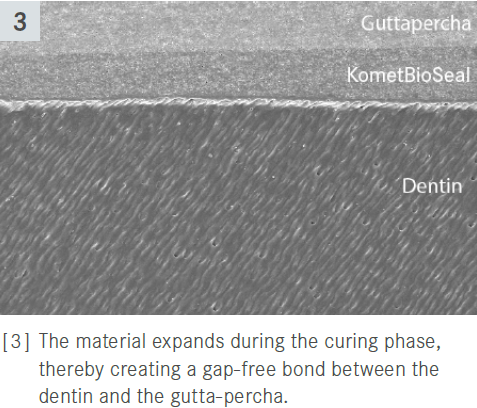

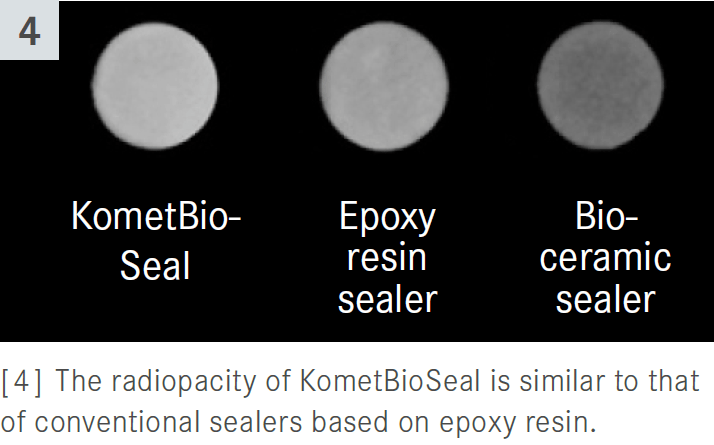
High radiopacity:
The specific composition of bioceramic sealers presents a major challenge in terms of radiopacity. KometBioSeal owes its outstanding radiopacity [ 4 ] to its optimized formulation containing zirconium oxide particles. The radiopacity of KometBioSeal is similar to that of epoxy based sealers and clearly superior to other bioceramic sealers, giving the user perfect control of the treatment result.

EasySeal
After a successful treatment of the root canal, the root filling is responsible for tightly sealing the canal to prevent reinfection
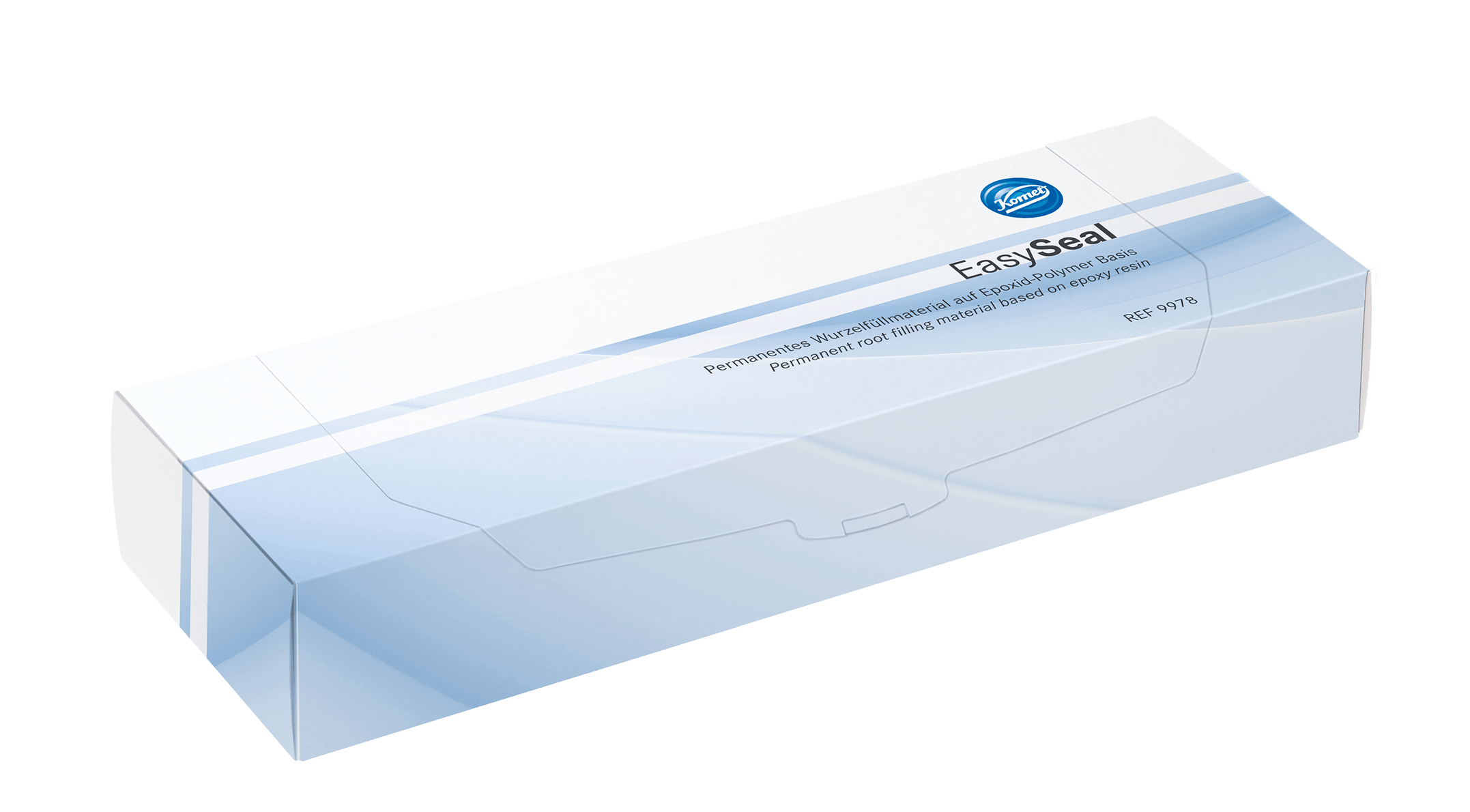
The high standard among sealers.

Permanent seal:
EasySeal is a root filling material on the basis of epoxy resin. The special composition of the matrial allows excellent adhesion to the dentin. A permanent seal can be guaranteed thanks to the low solubility and great resistance to high temperatures. With EasySeal, the root canal is duably protected from renewed bacterial attack.

Reduced risk of reinfection:
EasySeal is particularly flowable. Like this, even tiny dentinal tubules can be filled with EasySeal, safely preventing reinfections.

Fast and comfortable use:
The Easyseal root filling material comes in a twin-chamber syringe which allows safe and easy application without previous mixing. What´s more, te short setting time of 15 minutes allows a spreedy treatment.
Step by Step.
Clinical sequence:
1. Clean the root canal thoroughly and dry with paper points and an oil-free air jet fr approx. 10 seconds.
2. Before use, remove the cap of the double-chamber syringe by turning anti- clockwise. Check the level of the two components in the double-chamber syringe (see Fig. A-C). Attach a mixing cannula/ mixing tip (and Endo tip) and tighten by turning in a clockwise direction. Press both pastes into the mixing cannula by pressing the piston.
3. Squeeze Easyseal onto a mixing block, pick up and insert into the canal with a lentulo spiral.
Alternatively, select a suitable Masterpoint, cut apically, apply EasySeal and insert into the canal. The mixed root filling paste is workable for approx. 15 minutes.
4. Fill the root canal by means of condensation or thermoplastic techniques using gutta-percha. Full setting is reached at 37°C body temperature within 24hours
5. After use, remove the mixing cannula and close EasySeal with the sealng cap.
Root filling material on the basis of epoxy resin
A permanent apical seal of the root canal can be achieved with EasySeal, a root filling material based on epoxy resin. EasySeal is particularly suitable for orthograde filling techniques, it is radiopaque and dimensionally stable. EasySeal comes in a double-chamber syringe for easy, safe handling without need for previous mixing. The workable time of EasySeal is 15 minutes. Full setting is reached at 37°C body temperature within 24 hours.
Root filling materials based on epoxy resin, such as EasySeal, are classed as high standard thanks to their outstanding properties, for example excellent adhesion to dentin, low solubility and high thermo stability.

Leakage test with dye.
Root filling materials based on epoxy resin, such as EasySeal, are classed as high standard thanks to their outstanding properties, for example excellent adhesion to dentin, low solubility and high thermo stability.
EasySeal: The filling is tight, preventing bacteria from entering. The dye could not penetrate between the gutta-percha and the canal wall.
Commercially available sealer: The dye was allowed to penetrate right up to the guttapercha. The filling is not tight. No protection from renewed bacterial attacks.
Komet EnFill & EnPack
The combination for economical, simple and safe root canal obturations. Highly efficient, safe and homogeneous root canal filling – the perfect end of every endodontic treatment. Battery-operated, precise, ready for use in a flash.

With our obturation devices for warm, vertical obturation, you have the ideal combination in your hands to complete your endodontic treatments in an economically sound, comfortable and safe manner.
With EnPack and EnFill, you are always ready for action. You can get started straight away thanks to the extremely short heating times and work efficiently without interruptions.
Powerful rechargeable batteries without annoying cables, ease of operation thanks to the plug-and-play principle and the unique, rotatable displays ensure that you can concentrate fully on your work without worrying about the technology. A quick glance, a quick push of a button, a quick heat-up and you’re ready to go. EnPack and EnFill have everything you need to maintain your usual workflow. Both devices can be used universally, they meet almost any requirement thanks to the 360° rotatable injection needle and their heating tips in nine sizes. The devices allow you to work without fatigue thanks to their ergonomic design and low weight.
Increase your treatment efficiency with outstanding, homogeneous results in record time, from the apex to the canal entrance.
Komet EnPack. Efficiency in the root canal.
With our obturation device for warm, vertical obturation of the apical third, you can complete your endodontic treatments economically, comfortably and safely.
You are ready for action at any time, can get started straight away and work efficiently without interruptions. The heating tip heats up in just 0.2 seconds, so you don’t lose any valuable time during work and stay in the workflow. Simple plug-and-play operation, a display that is easy to read in any position and a powerful battery ensure that you only have to worry about your patient and not the technology.
EnPack makes clean, precise work particularly easy. It is suitable for universal use, i.e. by those who prefer a purely manual preparation as well as in conjunction with any endodontic motor. The nine heating tips with different diameters always offer an optimum view of the working area. Thanks to the low weight and ergonomic design of the device, you can work without fatigue. Precise separation of the master point is easy with the heating tip even when working with cold obturations – without clogging up and the risk of pulling the gutta-percha out again.
Rapid heating in the root canal ensures maximum patient safety and a perfect, homogeneous result.
Your highlights. Our promise.
Ready at any time
The heating tip heats up in just 0.2 seconds, so you can get started straight away. The tip heats up directly inside the canal, so that you increase the safety of your patients and ensure optimal processing of the gutta-percha.
Save time with every treatment
No lengthy preparation, just get started: With just two push buttons and a few settings, you can simply do your job without worrying about the technology. The simple operation allows you to react quickly and save valuable time with every treatment.
Full focus on what really matters
The tip comes in different diameters and offers an optimum view of the working area at all times. It reaches even narrow, deep areas and separates the gutta-percha with the utmost accuracy. This allows you to work in comfort and with maximum precision, without restrictions even in confined situations.
Equipped for every situation
With nine heating tip sizes and a precisely adjustable angle, almost any root canal can be filled efficiently. In just a few simple steps, your EnPack is ready for the next patient – precisely tailored to the requirements of the root canal.
Work comfortably
Work without fatigue: Thanks to its slim design, low weight and ergonomic handle, endodontic treatments with the EnPack can be done in perfect comfort. The design and display are suitable for both left-handed and right-handed users.
Highly secure
Fast heating time and rapid cooling offer the greatest possible safety for the patient and perfect results. The patient is additionally protected because the tip is heated up inside the root canal.
Versatile compatibility
As a stand-alone device, the EnPack is the perfect addition to any endo motor. Suitable for universal use, it pairs up ideally with the EnFill and perfectly complements our EnDrive.
Universal use
You can also benefit from the precision of the EnPack during cold obturation where it separates the master point cleanly and precisely. No clogging up, no risk of moving the gutta-percha, no risk of injury, just comfortable work with a sterile, clean result.
Flexible use
No annoying cables, just a battery that lasts for 1,500 treatments or 4 hours. When not in use, simply place your EnPack on the charging station and it charges up automatically.
Komet EnFill. Simple and safe filling.
With our obturation device for warm, vertical obturations, you can complete your endodontic treatments in an economically sound, comfortable and safe manner.
Thanks to the powerful rechargeable battery and the short heating time of only around 15 seconds, you are ready to go in no time at all and can carry out your filling without interruptions or delays.
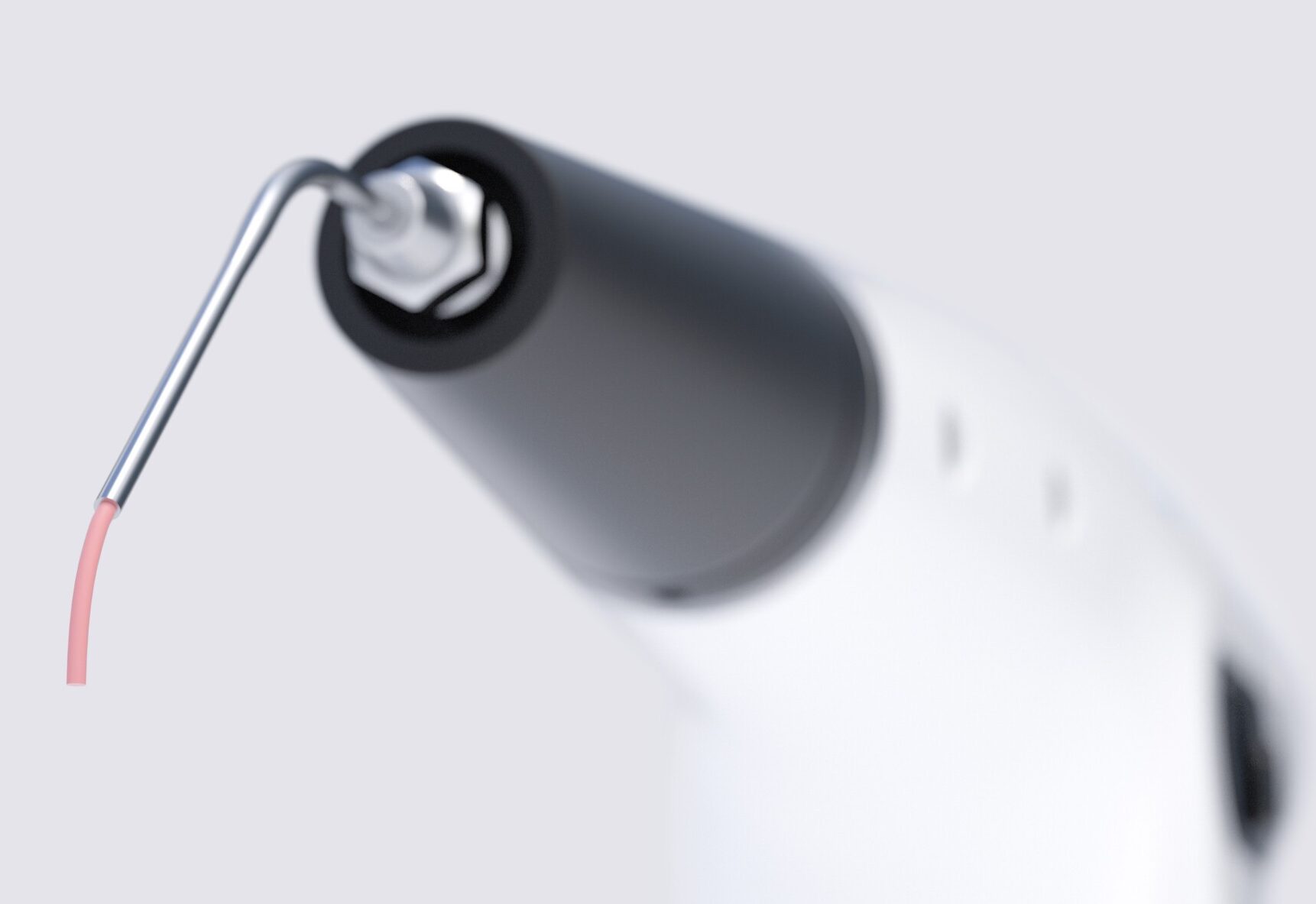
The six available injection needles can be optimally adapted to the requirements of the root canal and your preferences, as they can be rotated by 360°. They are so thin that you have a perfect view of the working area at all times and can fill the canal safely and precisely. Intuitive operation, fast responsiveness and fatigue-free design save valuable time during every endodontic treatment. The EnFill can be used by those who prefer manual preparations as well as in combination with any endodontic motor.
The lightweight, ergonomic pistol grip gives you full control over the filling volume and flow speed and follows your own workflow. Whether on its own or in combination with the EnPack as an ideal partner – with EnFill you will also reap the rewards for all the challenging work you have already done with your root canal preparation.
Why it pays off for you.
Stay efficient in the workflow
Stay in the workflow instead of waiting for your device. The EnFill heats the gutta-percha to the desired temperature in just 15 seconds. This allows you to continue working almost seamlessly, without interruptions.
Meets your requirements exactly
Every root canal is unique, just like your habits. That’s why each of the 6 available injection needles can be freely rotated by 360°, thus perfectly adapting to the changing requirements of your endodontic treatment.
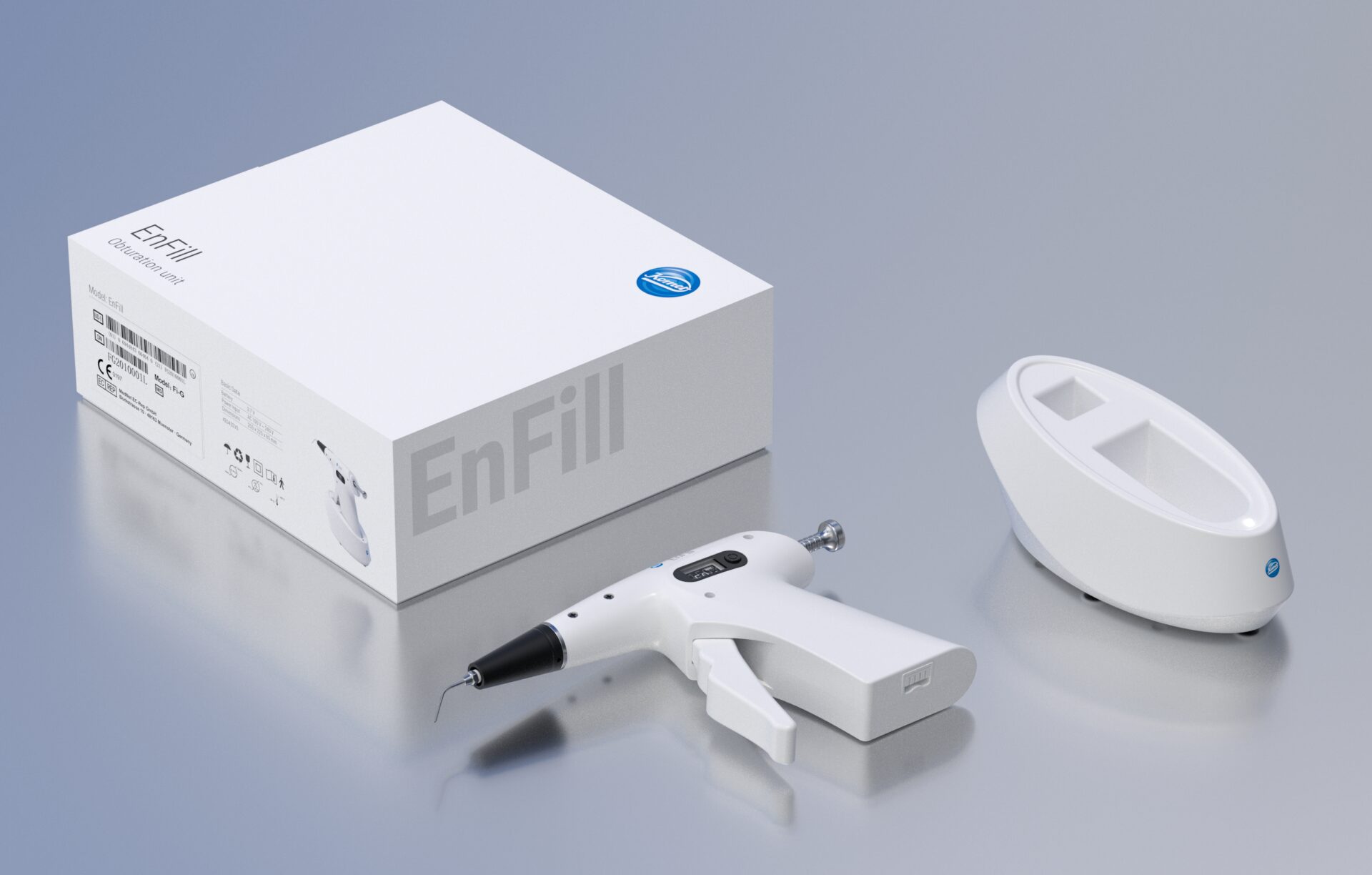
Full focus on what really matters
The EnFill injection needles come in different diameters so that you can safely reach almost any area that needs to be filled. They are so thin that you always have the best view of the working area, no matter how tight it gets.
Save time with every treatment
With just one push button and a few settings, you can simply get on with your work without having to worry about the technology. The easy operation allows you to react quickly and save valuable time with every treatment.
Work comfortably and precisely
Precise work without interruption or fatigue: The pistol grip is designed in such a way that you can easily and precisely control the flow rate and quantity of gutta-percha. Endodontic treatments can be carried out in complete comfort thanks to the low weight and ergonomic handle of the device.
Particularly safe
Fast heating-up period, short application time and rapid cooling to ensure the greatest possible safety for the patient and perfect results without loosening of the filling. The patient is additionally protected because the device heats up in the root canal.
Versatile compatibility
As a stand-alone device, the EnPack is the perfect addition to any endo motor. Suitable for universal use, it pairs up ideally with the EnFill and perfectly complements our EnDrive.
Flexible use
No annoying cables, just a battery that usually lasts for an entire day of use at the practice. When not in use, simply place your EnFill on the charging station and it will charge up automatically.
